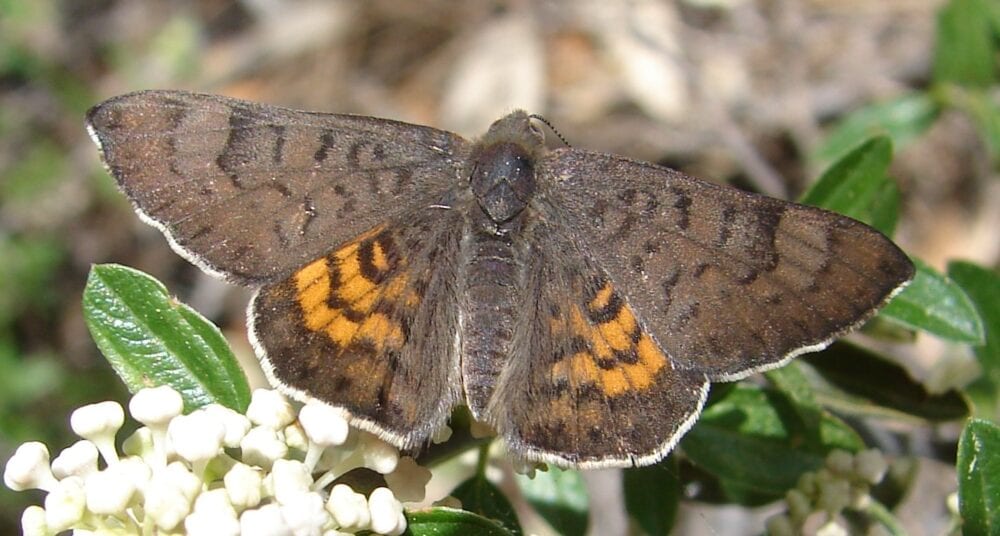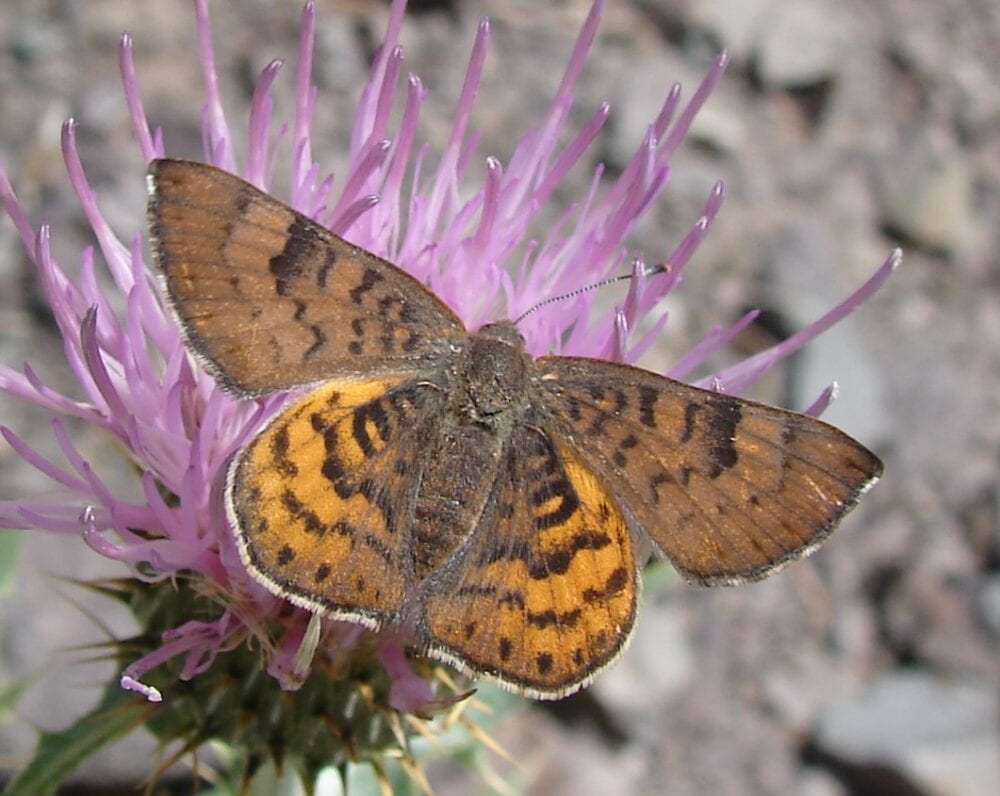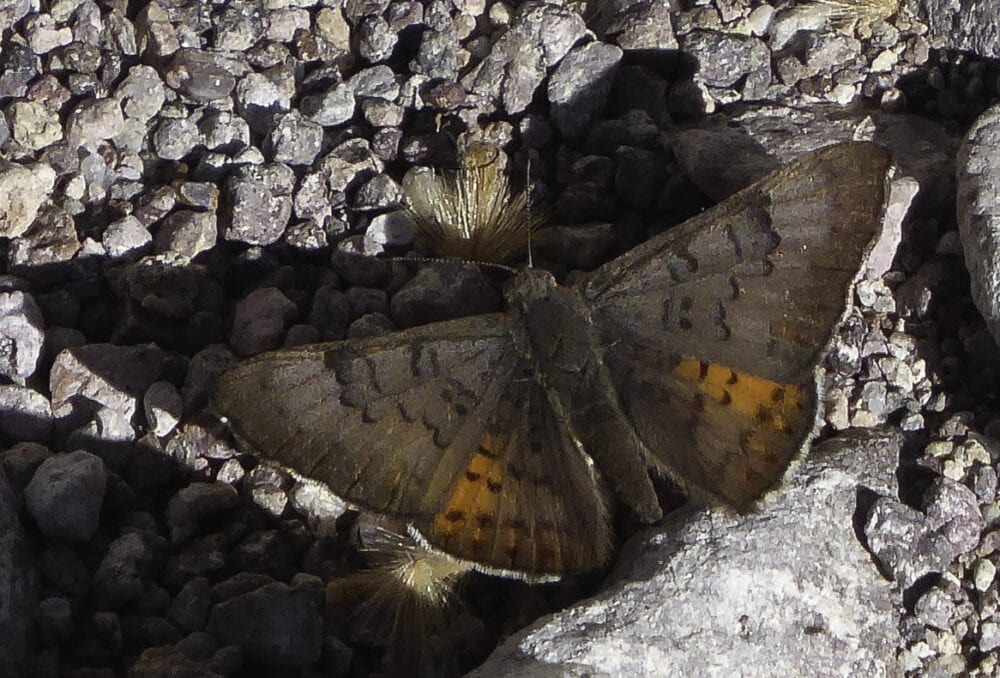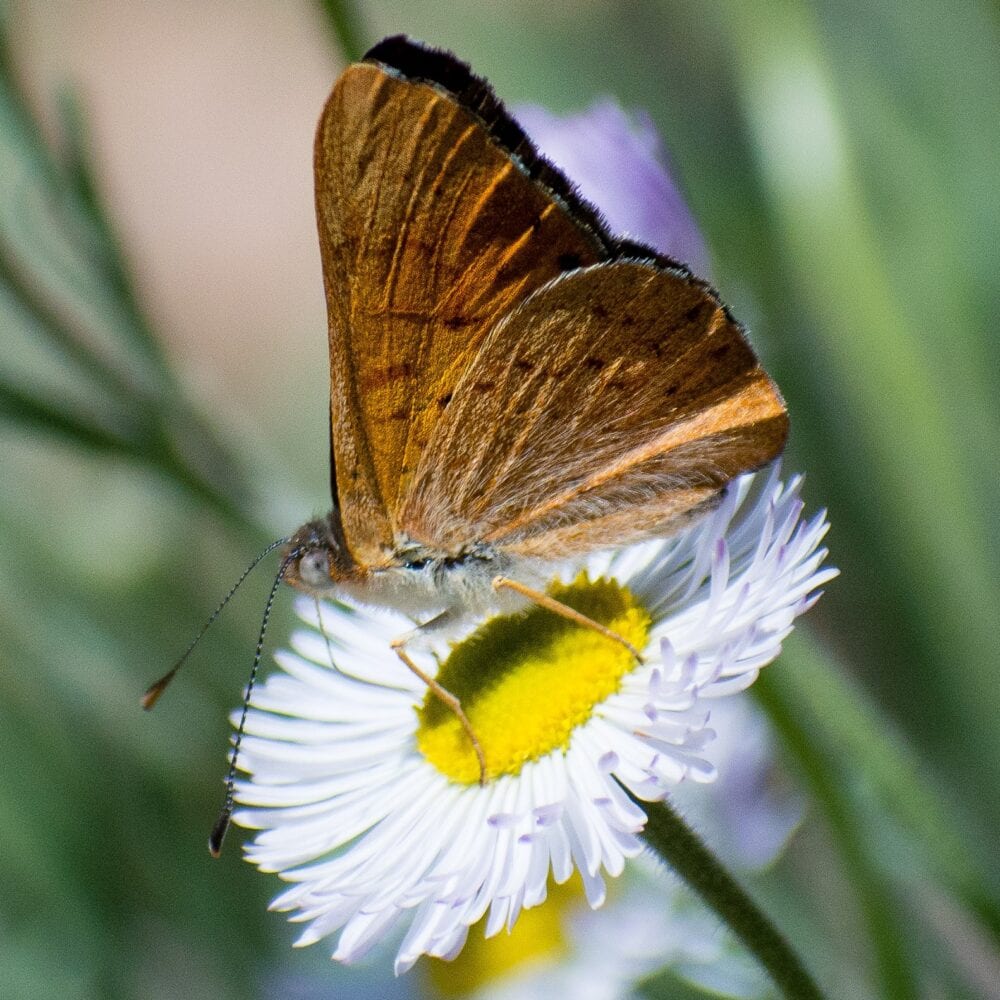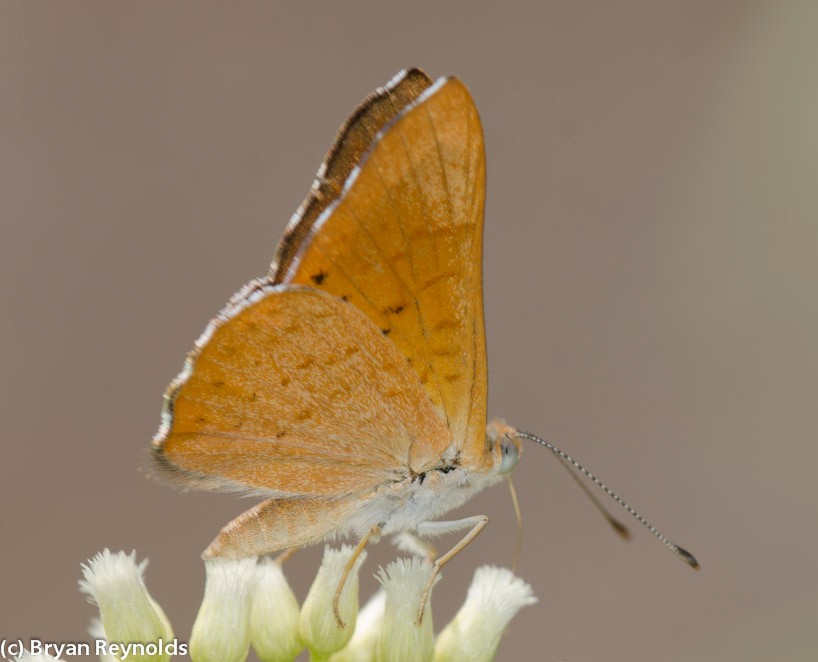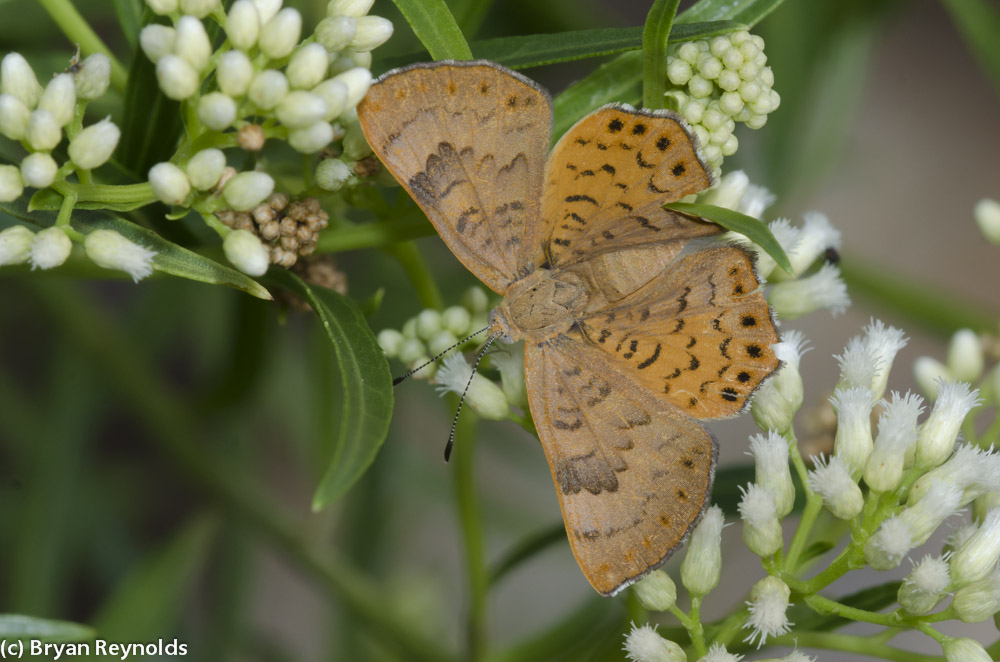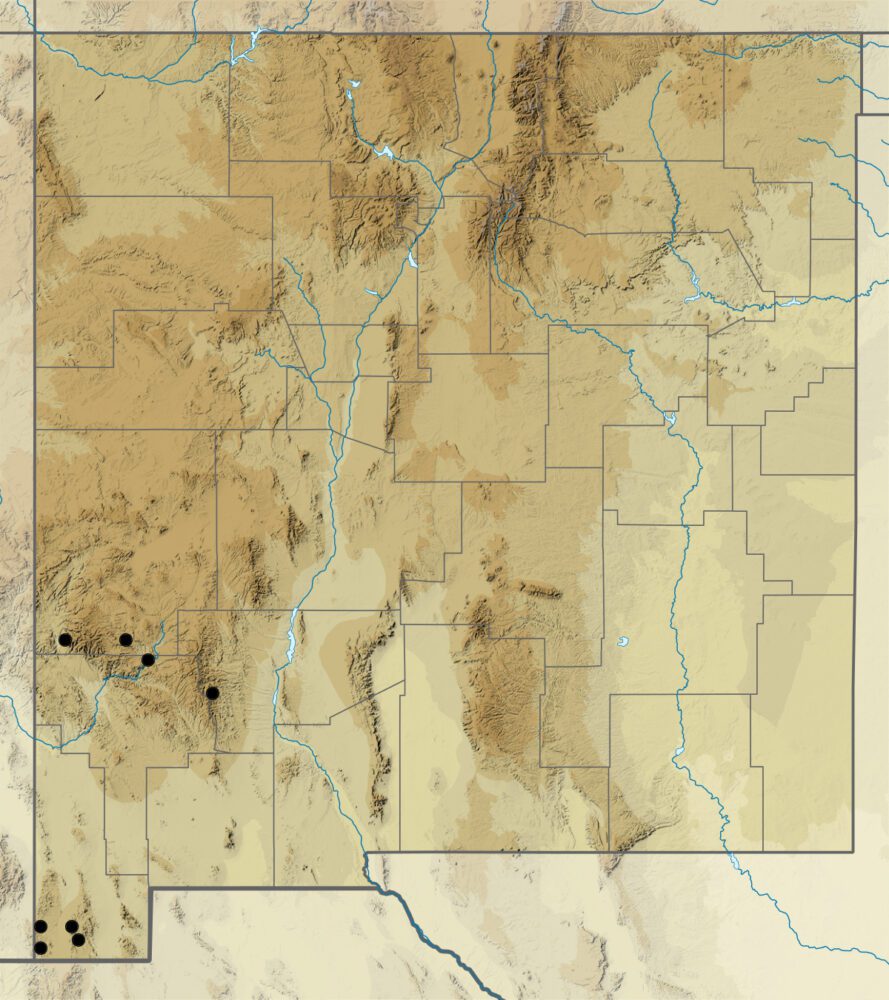by Steven J. Cary and Michael E. Toliver (updated March 28, 2022)
Metalmarks (Riodinidae). Members of the Metalmark family share some characteristics of Lycaenids and some of Nymphalids. Our 9 species are small with long antennae. Some have wings with tinsel-like, metallic highlights. This family erupts into more than 1,500 species in Central and South America.
- Fatal Metalmark (Calephelis nemesis) Calephelis nemesis australis
- Arizona Metalmark (Calephelis arizonensis) Calephelis rawsoni, Freeman’s Metalmark, Calephelis freemani
- Palmer’s Metalmark (Apodemia palmerii arizona)
- Hepburn’s Metalmark (Apodemia hepburni)
- Mormon Metalmark (Apodemia mormo autumnalis)
- Mexican Metalmark (Apodemia mejicanus) cythera, Apodemia mejicanus pueblo
- Dury’s Metalmark (Apodemia duryi)
- Little Jeweler, Nais Metalmark (Apodemia nais)
- Ares Emesis (Apodemia ares) Ares Metalmark
- Cleis Emesis (Apodemia cleis) Zela Metalmark
Calephelis nemesis (W. H. Edwards 1871) Fatal Metalmark (updated February 13, 2024)
Description. Among our smallest butterflies, Calephelis nemesis is about the size of a fingernail. Cool season individuals are dusky tan on the upperside with prominent brown median smudges set off by a pale postmedian band. Warm season individuals have a dark red-gray cast above with less contrast between median and postmedian areas. The forewing fringe is gray with a white check about midway around. On the underside it is tawny to bright yellow orange with black marks and delicate metallic filigree. See figures below. Range and Habitat. This miniscule butterfly lives in Mexico and the Southwestern U.S. In southern New Mexico, it prefers Upper Sonoran Zone riparian and semi-riparian environments (counties: Ca,Ch,DA,Ed,Gr,Hi,Lu,Ot,Si), usually below 5000′ elevation. Life History. Seepwillow (Baccharis glutinosa; Asteraceae) and Virgin’s Bower (Clematis ligusticifolia; Ranunculaceae) are known larval hosts. Flight. Calephelis nemesis has at least two annual broods per year here. Our records extend from April 18 to November 20, clustering in June and again from August to October. Adults fly near the ground and come to nectar. Comments. Differentiating Fatal and Arizona metalmarks (the next species) can be complicated by intermediacy in some key visual characters. Individuals from the southeastern counties (Ch,DA,Ed,Ot) may represent the central Texan subspecies Calephelis nemesis australis (W. H. Edwards, 1877)
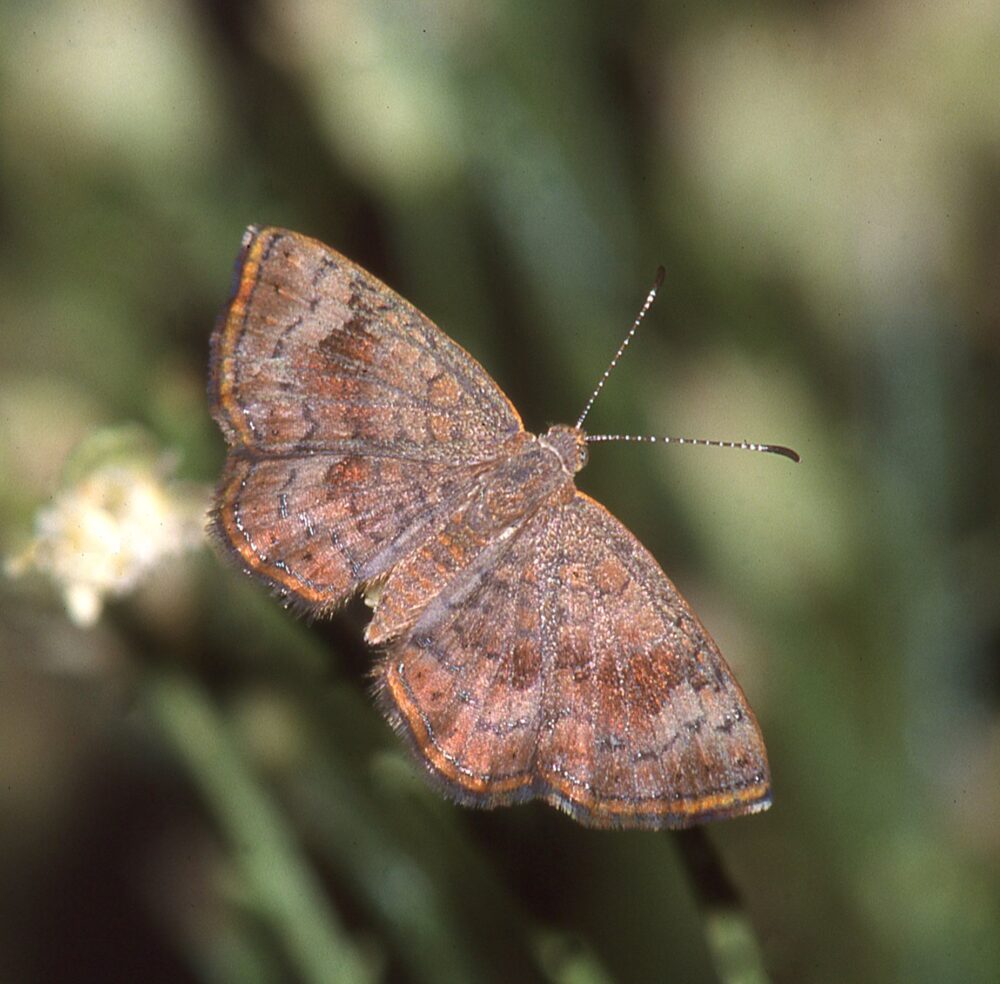
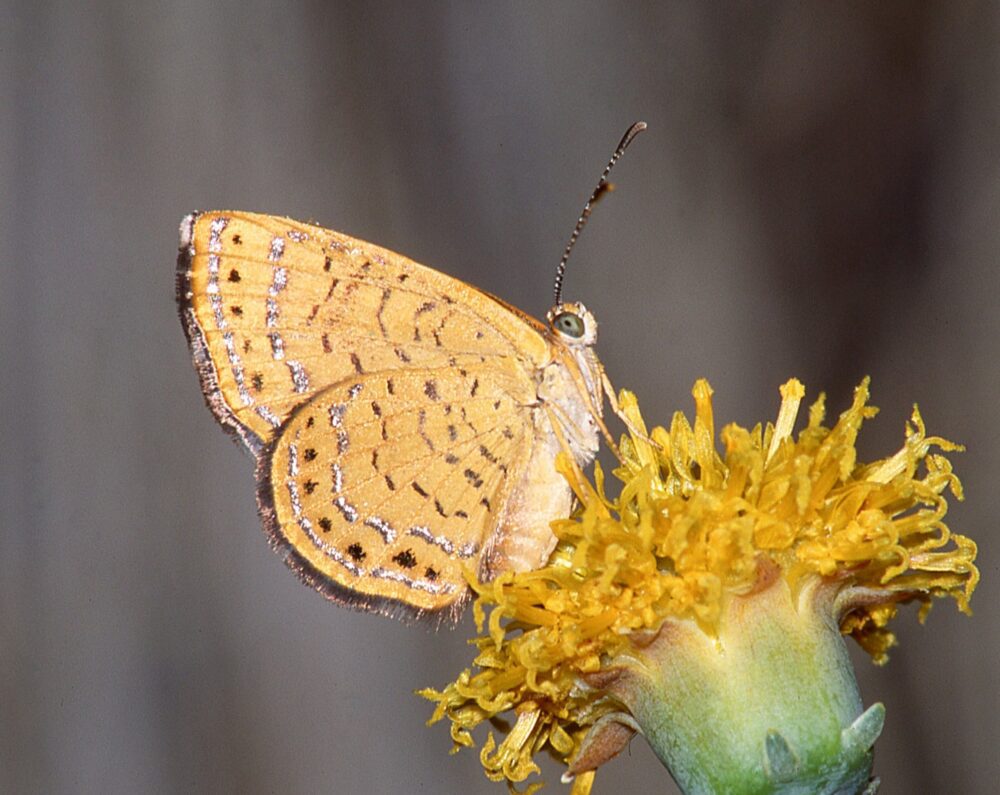


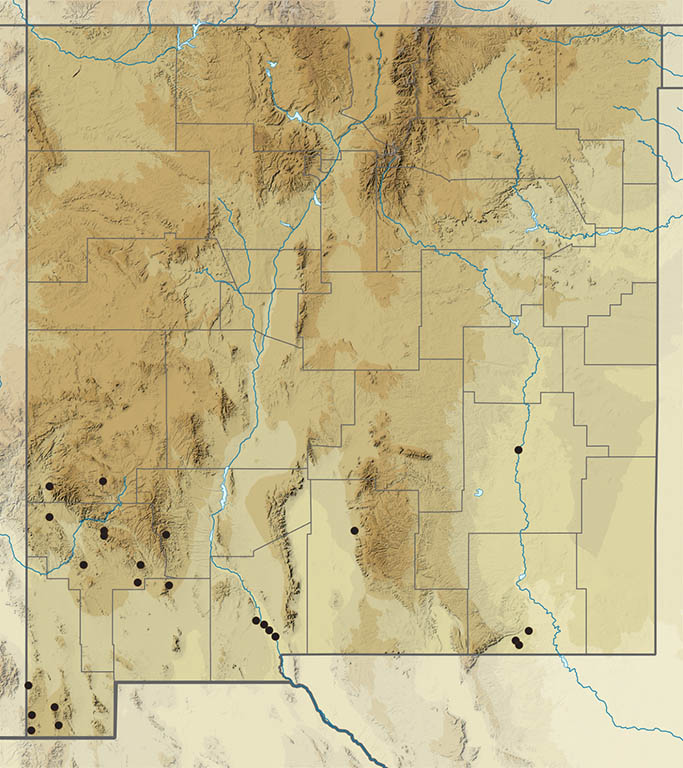
Calephelis arizonensis McAlpine 1971 Arizona Metalmark (updated March 16, 2022)
Description. Calephelis arizonensis is nearly identical to C. nemesis, but with a reddish hue above and distinctly checked wing fringes. It usually lacks Fatal Metalmark’s post-median smudges and the postmedian band is not wide and pale as in Fatal. Species determinations can be challenging; in fact, it can be impossible without genitalic examination. Range and Habitat. Arizona Metalmark is mostly Mexican, but it reaches into the SW US where it prefers foothill riparian settings in desert mountains. It may be rare in New Mexico’s SW corner (counties: Gr,Hi,Lu), 4600 to 6000′ elevation, slightly higher in the landscape than Fatal. Very little is known about its possible occurrence here. For example, it is not generally thought to be migratory, so do NM observations reflect breeding populations or simply misidentified C. nemesis? More confirmed observations are needed. Life History. Jim Brock says the larval host in Arizona is Arizona beggarticks (Bidens aurea, Asteraceae), a species which may not occur in New Mexico. However, we do have other species of Beggarticks, some of which occur in areas where the Arizona Metalmark has been recorded. Flight. Arizona Metalmark sometimes flies with C. nemesis and shares a similar brood sequence, adding more opportunities for confusion. We have about 10 New Mexico reports spanning the dates of June 6 through October 10, favoring September. Adults patrol drainages and nectar at streamside flowers. Comments. Some experts have treated this butterfly as a subspecies of Calephelis rawsoni McAlpine 1939. A different species of Calephelis, Freeman’s Metalmark (Calephelis freemani), closely approaches our southern border and may eventually be found here.
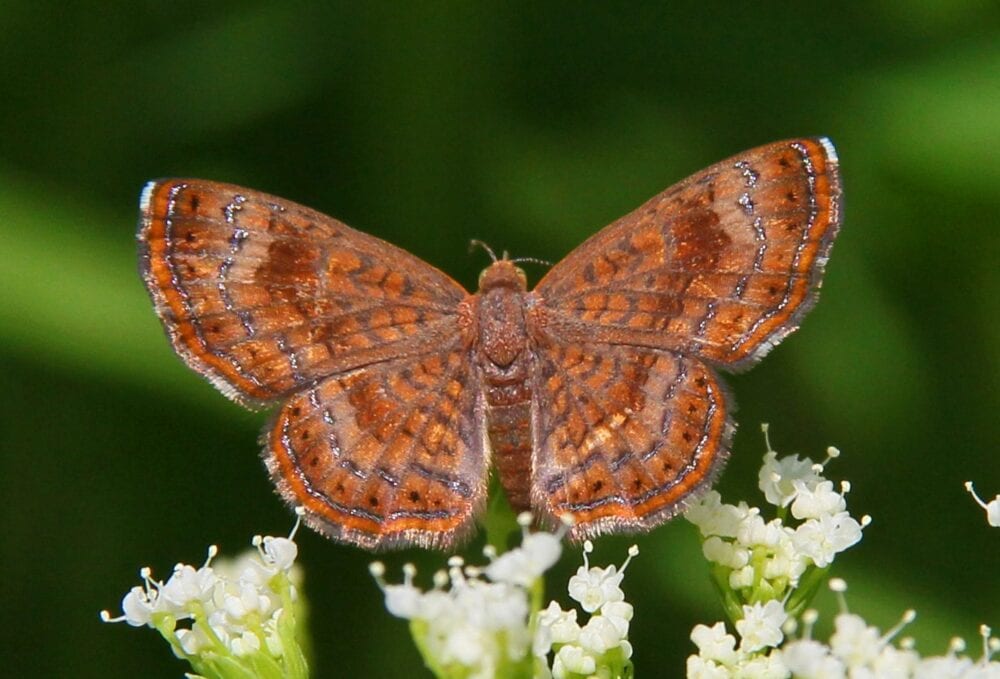
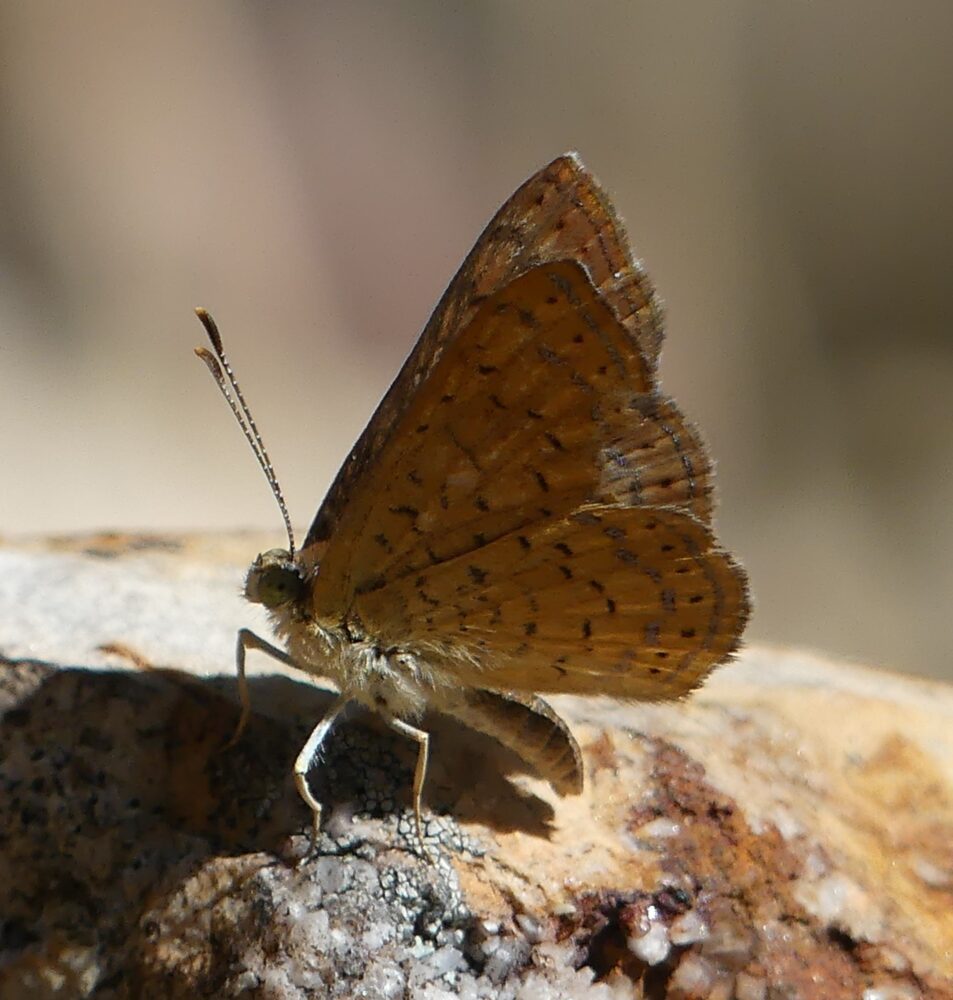
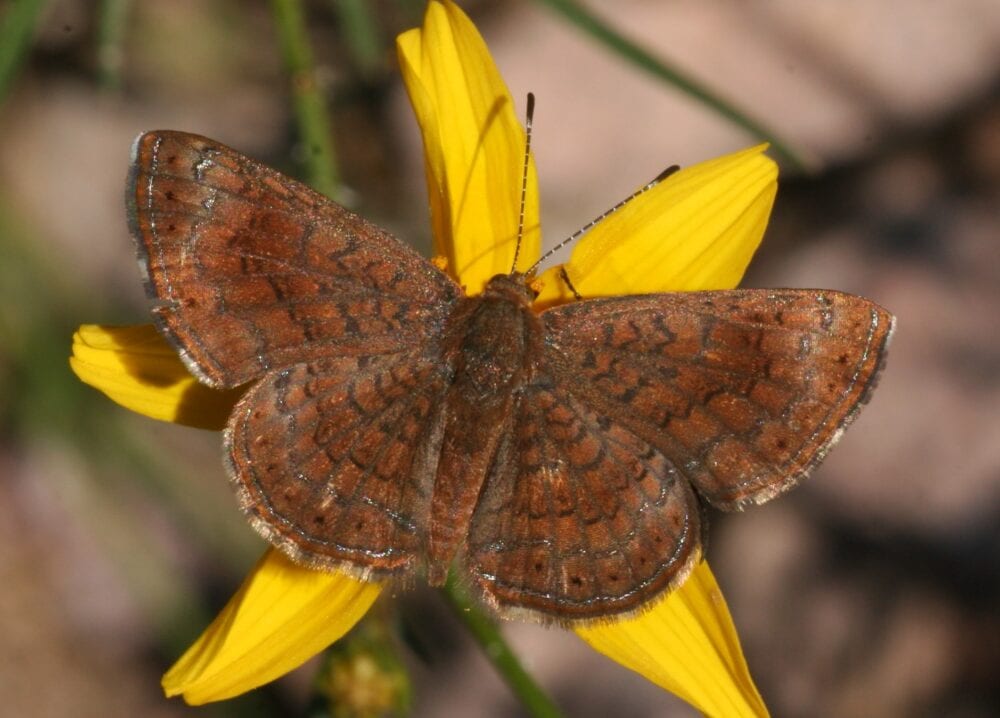
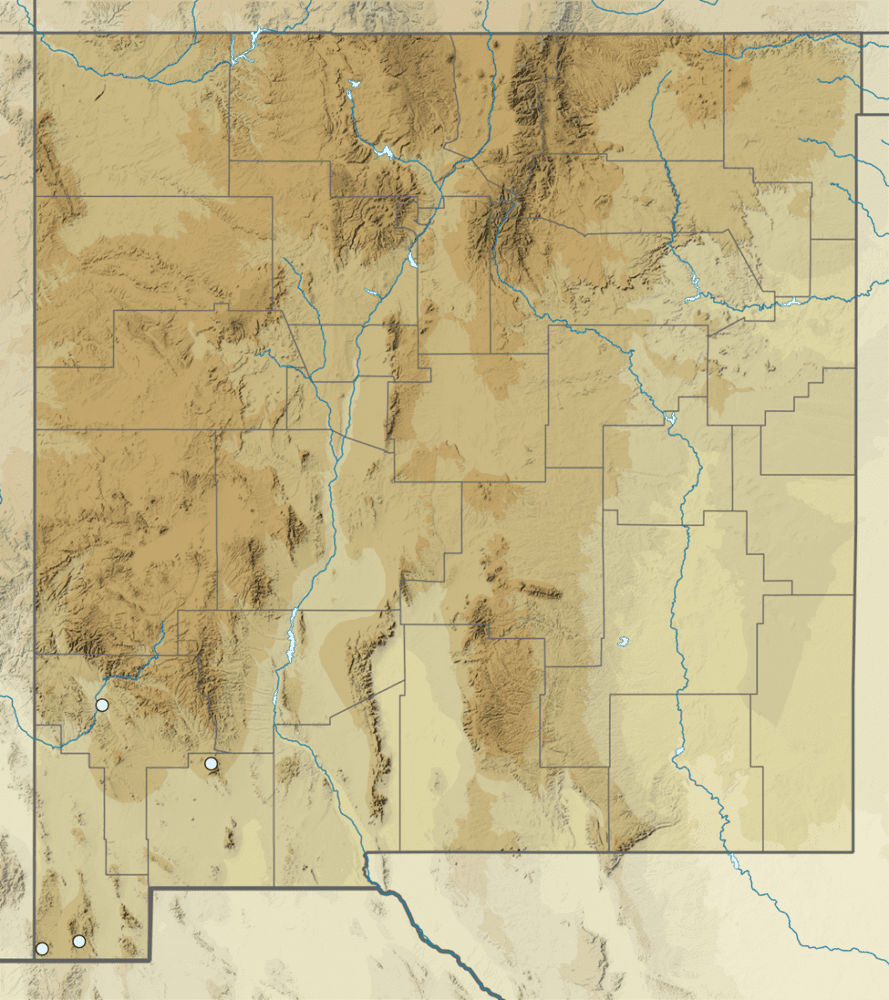
Apodemia palmerii (W. H. Edwards 1870) Palmer’s Metalmark (updated February 15, 2024)
Description. Palmer’s Metalmark has the general markings of the Apodemia genus, but it is the smallest of the bunch – only the size of a Calephelis. White spots decorate a rust and dark gray background on the upperside. The underside background is pale orange and light gray. A closely related species, Hepburn’s Metalmark (Apodemia hepburni Godman & Salvin), is easily confused with Palmer’s. Hepburn’s is darker on the dorsal surface and lacks a submarginal row of spots on the FW. Range and Habitat. From central Mexico to the Southwest US, Palmer’s Metalmark lives in mesquite flats and lowland riparian corridors. It breeds at least seasonally in southern NM (counties: Be,Ca,DA,Ed,Gr,Hi,Li,Lu,Ot,Si,So,Va) usually below 5500′. Though small, it may wander northward and upslope to 8000’. Life History. Documented larval hostplants are mesquites (Fabaceae), including Prosopis glandulosa and P. pubescens. Partially grown larvae diapause overwinter. Flight. There are two annual broods in NM: May to June and August to September. Extreme dates are May 19 and October 14. Adults frequent host mesquites and visit nearby nectar. A warming climate could help this species breed year-round in southern New Mexico. Comments. NM populations may be assignable to ssp. Apodemia palmerii arizona (Austin [1989]). Our oldest report is a specimen in the AME collected by Professor C. H. T. Townsend at Las Cruces (DA) on 28 August, c. 1890.

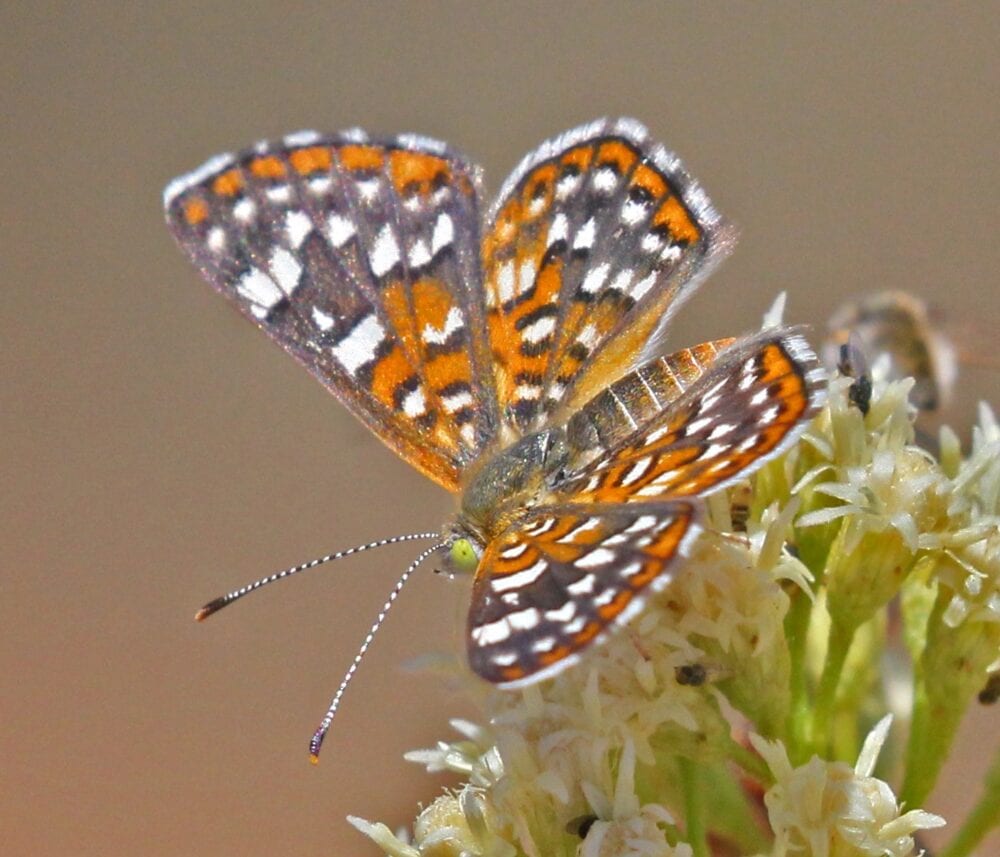
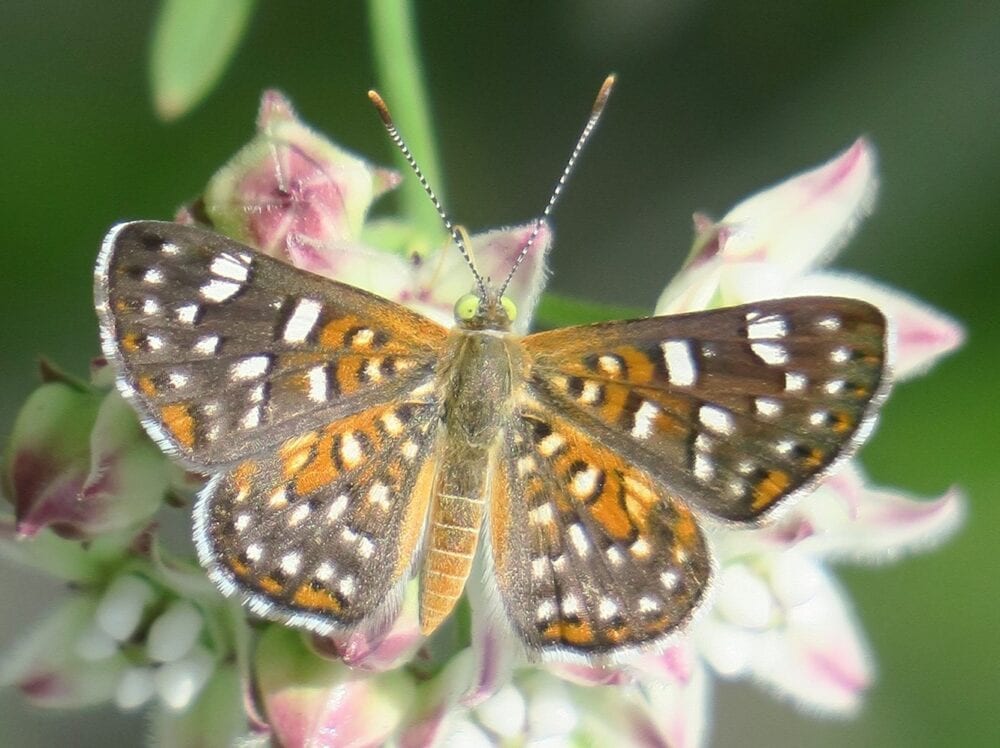
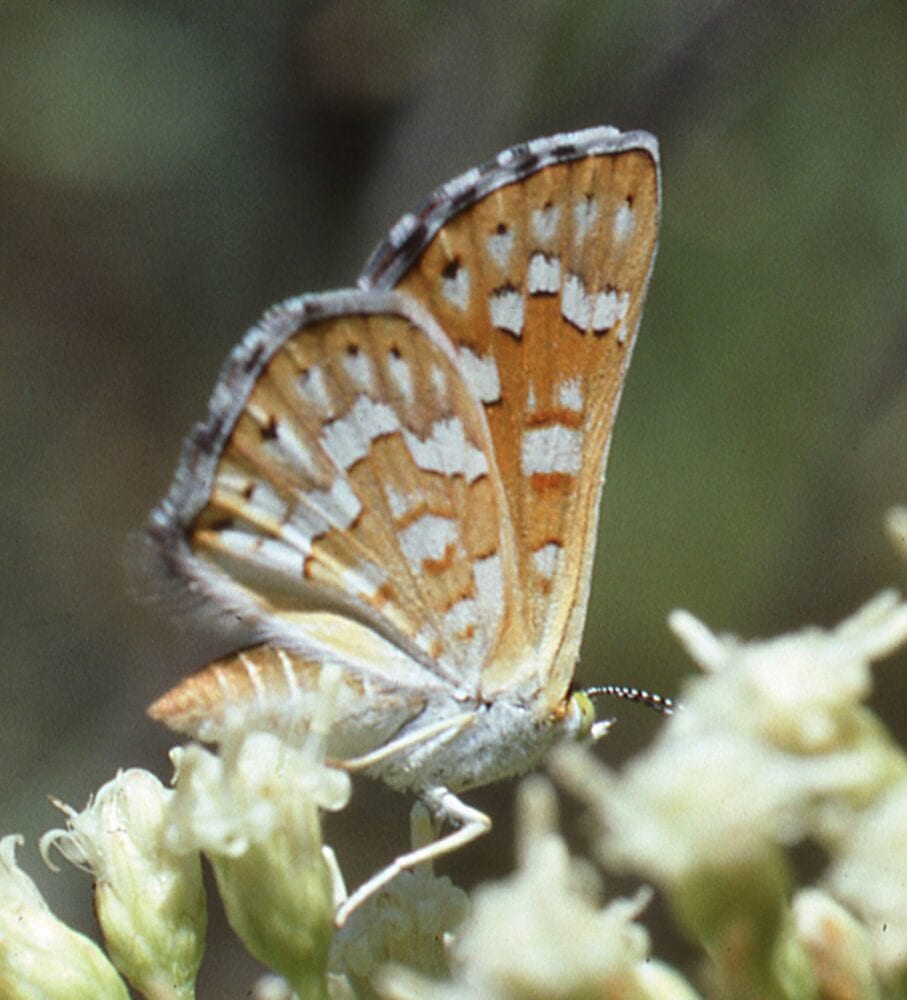
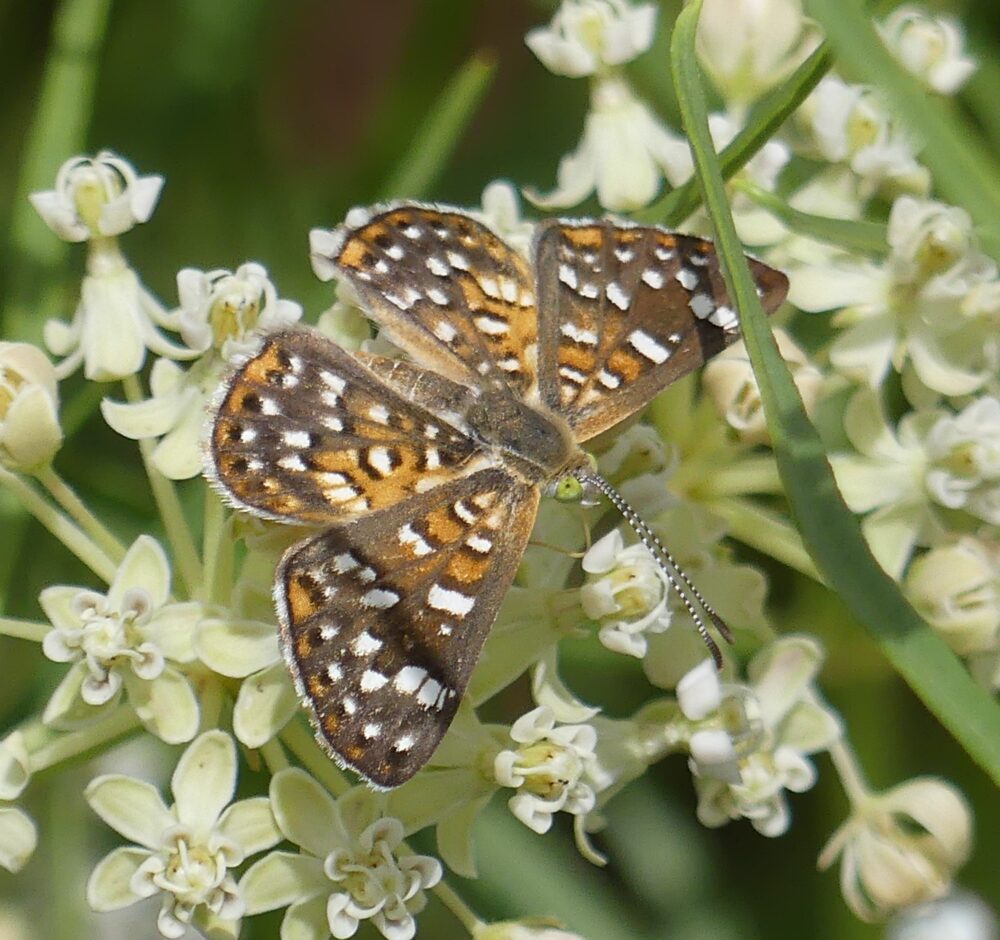

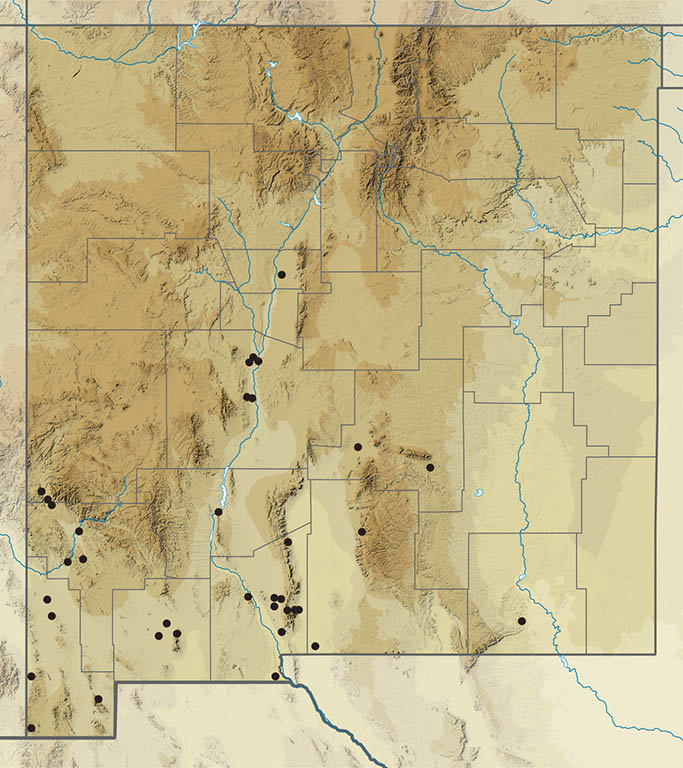
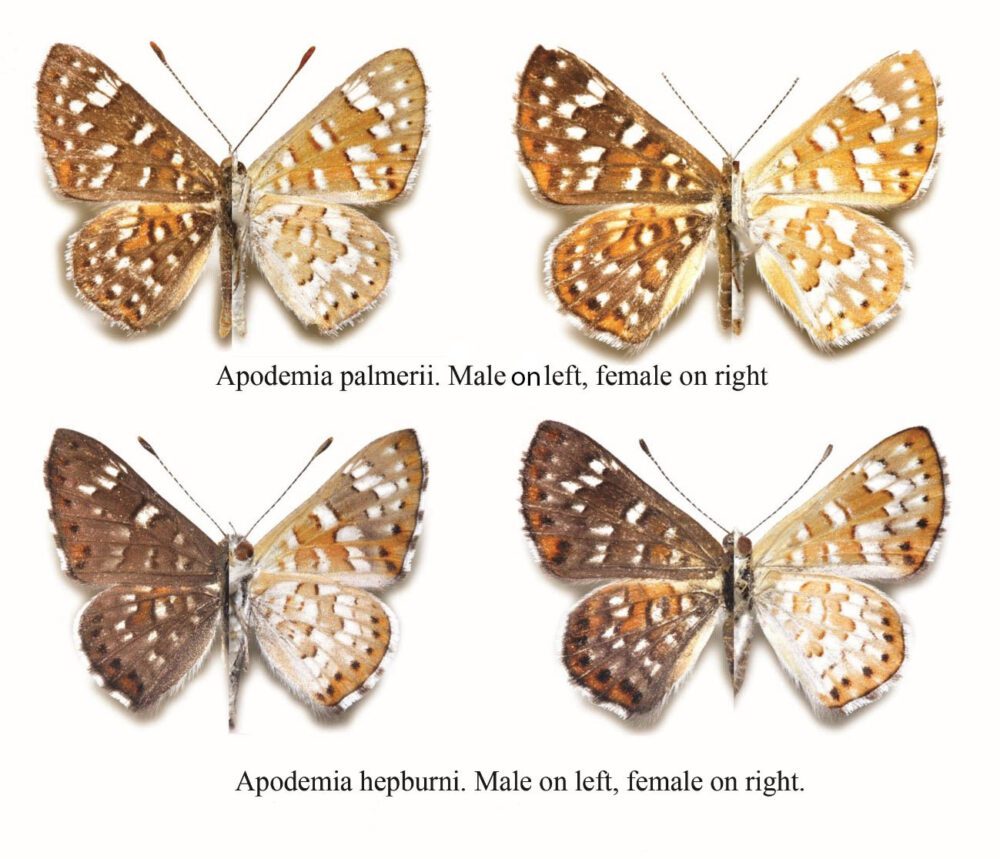
Apodemia hepburni Godman & Salvin 1886 Hepburn’s Metalmark (added October 19, 2023)
Description. Very similar to Palmer’s Metalmark; distinguished from that species by the lack of obvious submarginal white spots on the dorsal forewing. Beneath, virtually identical to Palmer’s, but perhaps with more contrast between the various markings. Most Hepburn’s tend to be darker than your average Palmer’s, but that character varies individually and sexually. Range and habitat. Hepburn’s Metalmark is primarily a Mexican species, which ranges into SE AZ, SW NM and W TX as a stray. Life history. Larval stages are unknown, so we don’t know the host plant. Association of northernmost breeding colonies of Hepburn’s with the northernmost colonies of Mexican Ebony, Harvardia mexicana (Fabaceae), suggests that tree should be investigated as a possible host (Bailowitz & Brock 2022). It is not native to our area, but spreads into the SW US with human intervention (https://apps.cals.arizona.edu/arboretum/taxon.aspx?id=829). Flight. All AZ records are from August – November. Our single record is from October. Comments. Discovered in Guadalupe Canyon (Hi) on 7-x-2023 by Christopher Rustay and Mike Shoop. It has previously been recorded on the AZ side of Guadalupe Canyon.
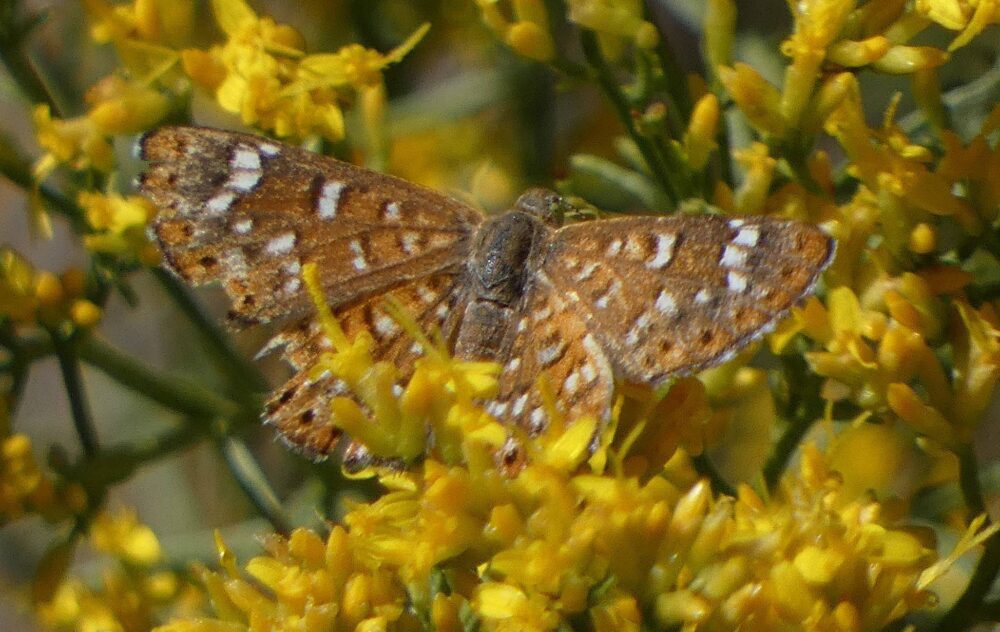

Apodemia mormo (C. Felder & R. Felder 1859) Mormon Metalmark (updated February 16, 2024)
Description. Like all members of this complex, Mormon Metalmarks are about the size of a fingernail, maybe a thumbnail. Solid black ground color on the dorsal hindwing and rear portion of the dorsal forewing distinguishes this species from related forms. Mormon shares with those other forms a dorsal pattern of white spots, some triangular. It is orange on VFW and silver-gray on ventral hindwing, both with white spots. Eyes are green or yellow-green. Range and Habitat. This butterfly occupies arid shrublands from California eastward onto the Colorado Plateau in northwestern NM (counties: Ca,MK,RA,Sv,SJ,SF,Ta), 6000 to 8000’ elevation. Life History. Larvae eat wild buckwheats (Polygonaceae) including at least Eriogonum wrightii, E. corymbosum, E. leptocladon, E. lonchophyllum and E. microthecum. Flight. Apodemia mormo is univoltine in New Mexico adults with adults on the wing in late summer, July 22 to September 29. Adults rarely stray far from host buckwheats. Comments. According to Pelham (2022), we have subspecies Apodemia mormo autumnalis Austin 1998. An unnamed segregate of this species occurs in SE AZ (Pelham 2022) and should be looked for in adjacent NM (Hi). The “mormo” complex of metalmarks (A. mormo, A. mejicanus and A. duryi in NM) is in a state of continual taxonomic flux. This is testament to its complexity. Our present treatment follows current understanding of this group, but anticipate changes! Some individuals from populations on the Taos Plateau (Ta) and west-central NM (Ca) show some intermediacy with Apodemia mejicanus, perhaps due to past genetic introgression, but the “eye” test should resolve the issue: green eyes = mormo while gray eyes = mejicanus.
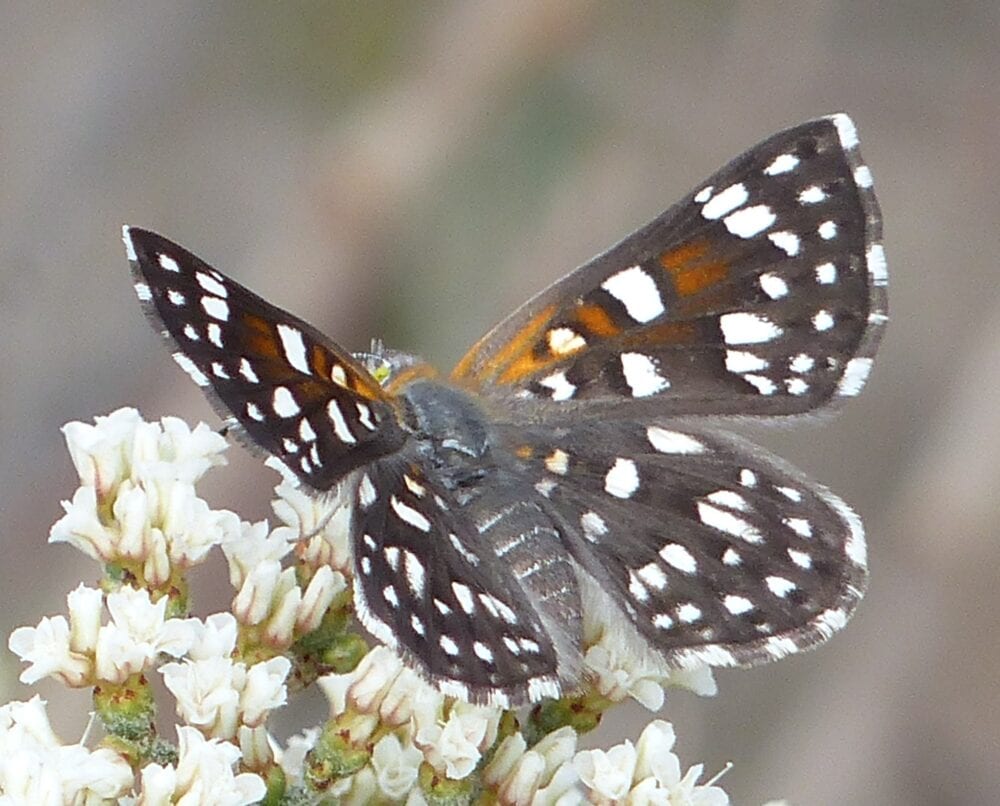

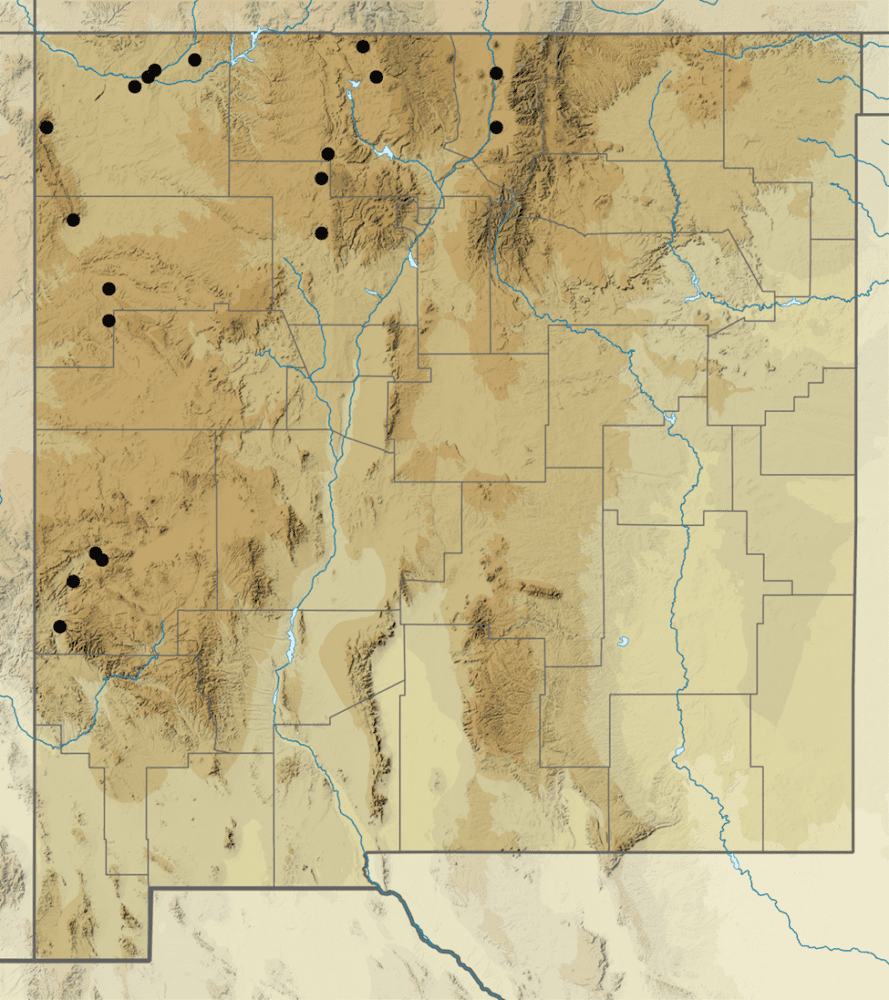
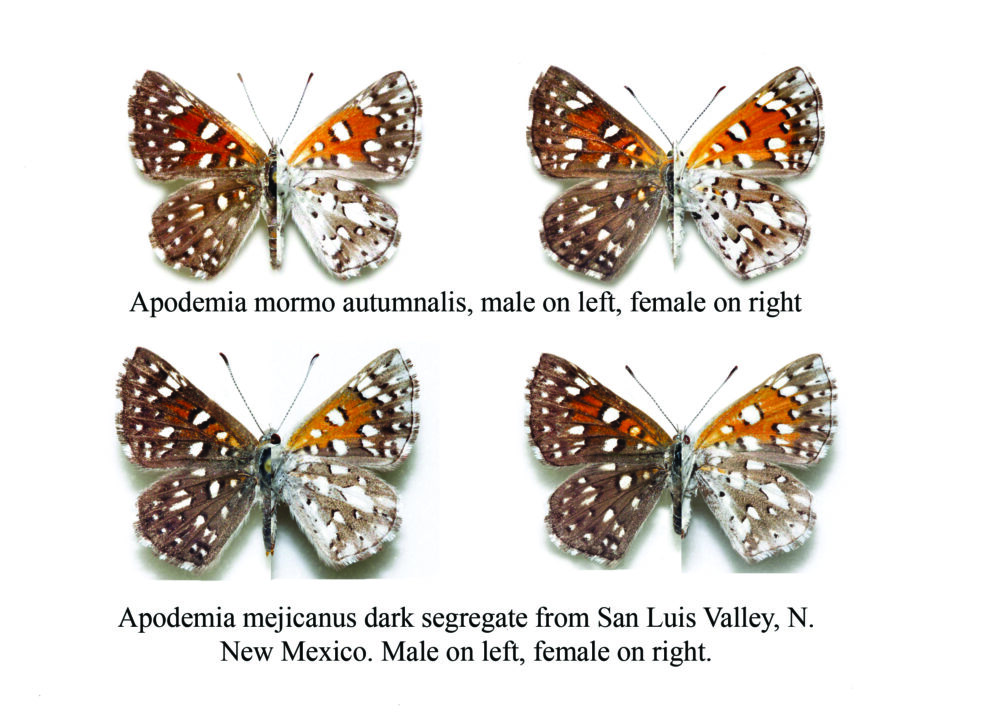
Apodemia mormo vs. Apodemia mejicanus: These two species can be extremely confusing. The figure below may help in identifying your metalmark, but users should be aware that our knowledge of these insects is evolving.
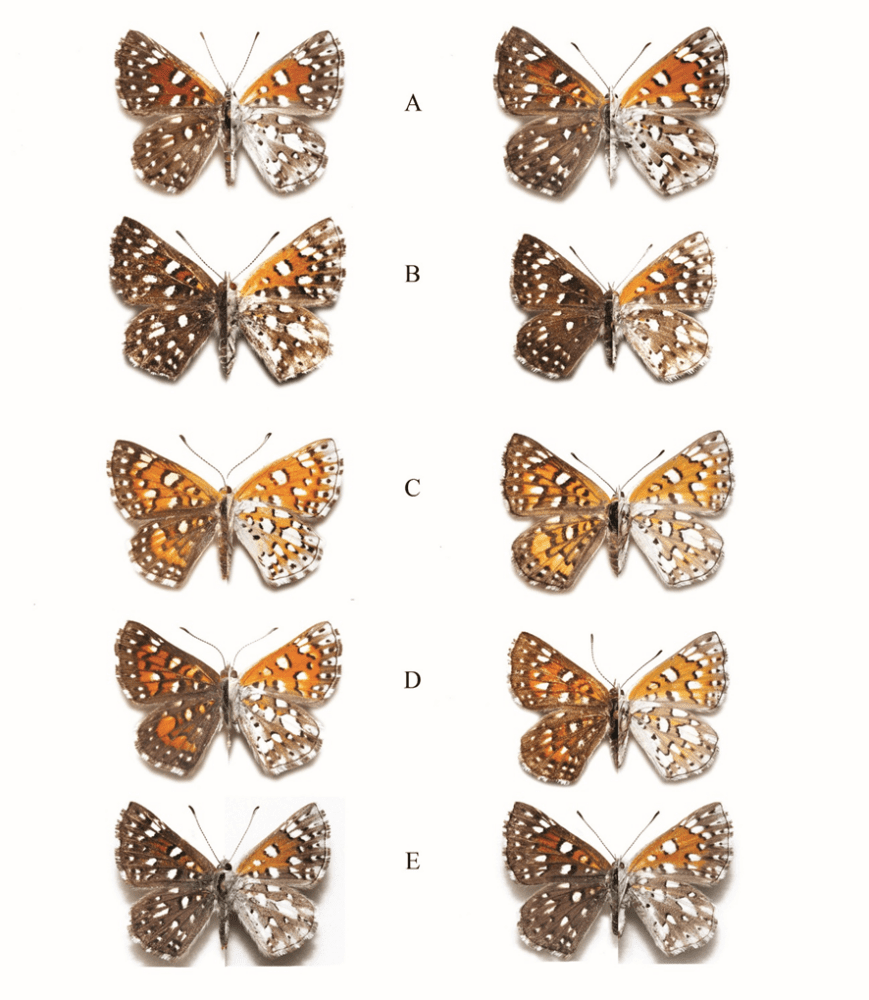
Apodemia mejicanus (Behr 1865) Mexican Metalmark (updated August 28, 2024)
Description. Apodemia mejicanus has gray eyes throughout its range in New Mexico, which distinguishes it from all other Apodemia species. The dorsal ground color of Mexican Metalmark is dirty orange on forewings and hindwings, whereas Apodemia duryi is comparatively bright medium orange dorsally and Apodemia mormo has no orange at all on the dorsal hindwing. Ventrally, a thin, interrupted line of orange scales spears the mottled gray and white hindwing of the nominate subspecies, Apodemia mejicanus mejicanus. For subspecies Apodemia mejicanus pueblo J. Scott 1998, ventral hindwings typically have more orange, with veins often brightly painted with orange; this phenotype also turns up occasionally in Hidalgo County. Here we call this Front Range Mexican Metalmark. Range and Habitat. Mexican Metalmark is distributed along the US/Mexico border from coastal California and Baja eastward through northern Mexico, southern Arizona, and New Mexico to west Texas. Within our state, one form of this butterfly inhabits Upper Sonoran Zone grasslands and shrublands in central and southern New Mexico (counties: Be,Ca,DA,Gr,Hi,Lu,Sv,SF,Si,So,To,Va), usually 5000 to 6500’ elevation. A second version lives in higher Transition Zone shrublands and savannas in north-central New Mexico mostly east of the Rio Grande (counties: Co,Mo,RA,SM,SF,Ta,Un) from 6500 to 8500’ elevation, and in south-central New Mexico mountains (counties: Ca,Li,Ot,Si) from 7500 to 9500’ elevation. Life History. Larvae eat wild buckwheats (Eriogonum species; Polygonaceae). The larval host for southern New Mexico grassland populations is Eriogonum wrightii (Wright’s Buckwheat, Bastard Sage). The larval host for northern and southern mountain populations is Eriogonum jamesii v. jamesii (Antelope Brush). Flight. Mexican Metalmarks at lower elevations fly in two well-defined generations: April to May and August to October. Higher elevation populations are single brooded in summer only, from July to September. Adults fly near the ground, go to nectar, and rarely wander far from host buckwheats. Comments. One reason to distinguish nominate A. m. mejicanus from subspecies A. m. pueblo appears to be voltinism (two versus one brood per year), though that may simply reflect the altitude at which each is found. Geography would also seem to be important, with populations from central and southern New Mexico placed with typical mejicanus and populations from northern New Mexico placed with pueblo. The original description of pueblo states “This ssp. resembles mejicanus (Behr) of S Ariz.-W Tex., except the basal two thirds of uph has less orange. It resembles cythera (Edw.), but there is less orange on the rear of upf than on cythera, and the upf color is redder than the orangish upf of cythera.” Different larval host plants may also be a factor. To date, spring and autumn broods have not both been documented for every colony placed with A. m. mejicanus. Apodemia mejicanus pueblo was described from the Front Range in southern Colorado. We place records from NE New Mexico (counties Co,SF,SM,Sv,Ta,Un) with this subspecies. Apodemia mejicanus pueblo occurs with Apodemia mormo in and around the Rio Grande Gorge on the Taos Plateau (Ta) where some intermediate phenotypes are seen, but the two can be distinguished based on eye color. Pelham (2022) recognized a segregate of mejicanus occurring along the Rio Grande in the San Luis Valley southern CO and northern NM. Apodemia mejicanus mejicanus may co-occur with Apodemia mormo in west-central New Mexico (Ca), too. Zones of sympatry clearly warrant study. In the Organ Mountains of Dona Ana County, confusion between A. mejicanus and A. duryi is due to some overlap in wing characters rather than to hybridization. They separate definitively by eye color. Big picture and long term, no knowledgeable person thinks that what we call mejicanus in NM is truly the same species as the one that flies in Mexico were the type of mejicanus was taken; they just look alike. Odds are good that some clever researcher will soon have a new name for this creature, so stay tuned.
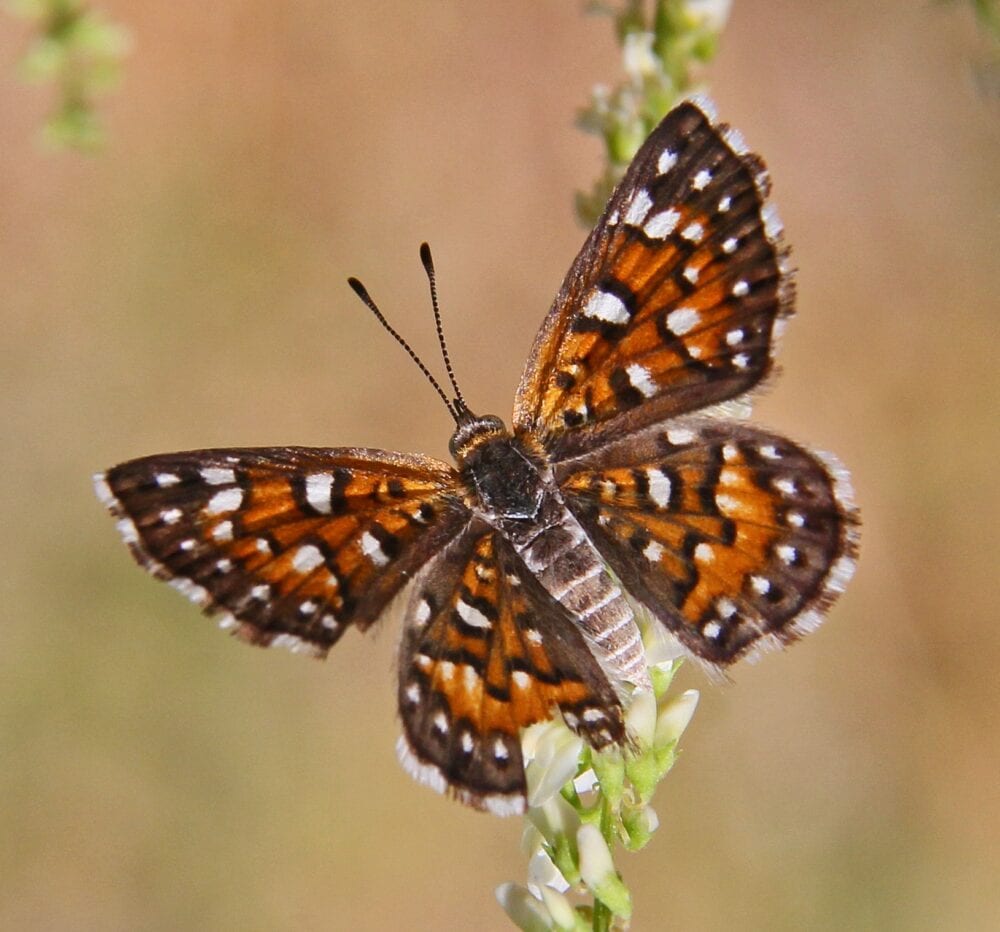
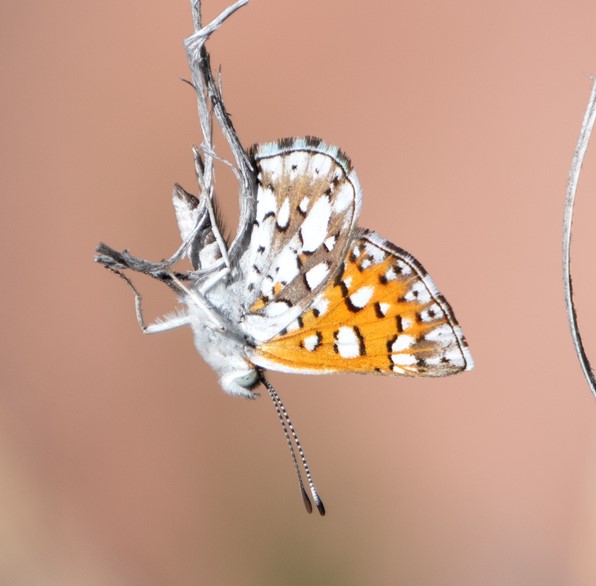
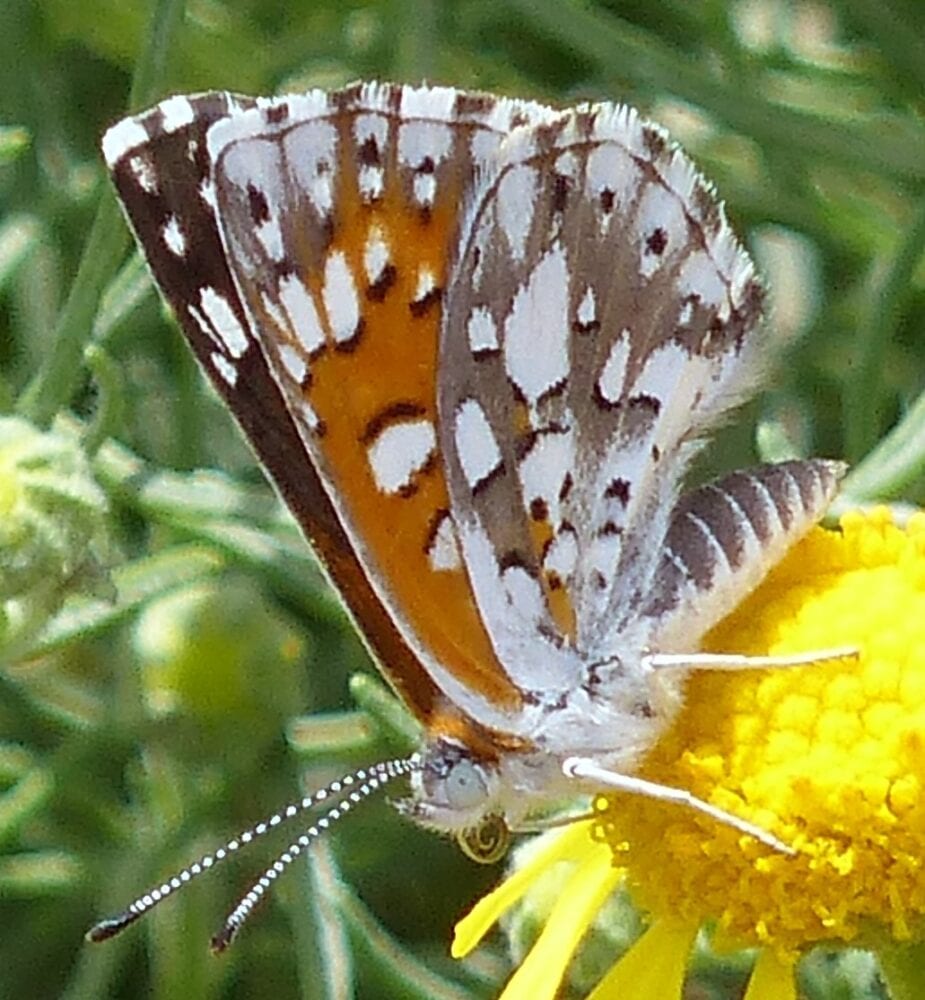
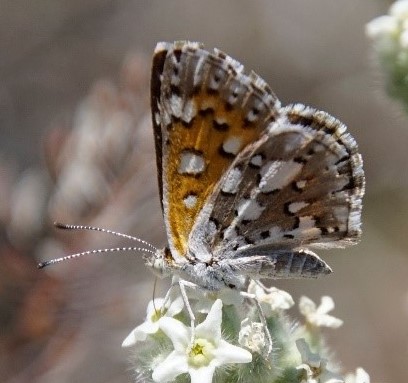
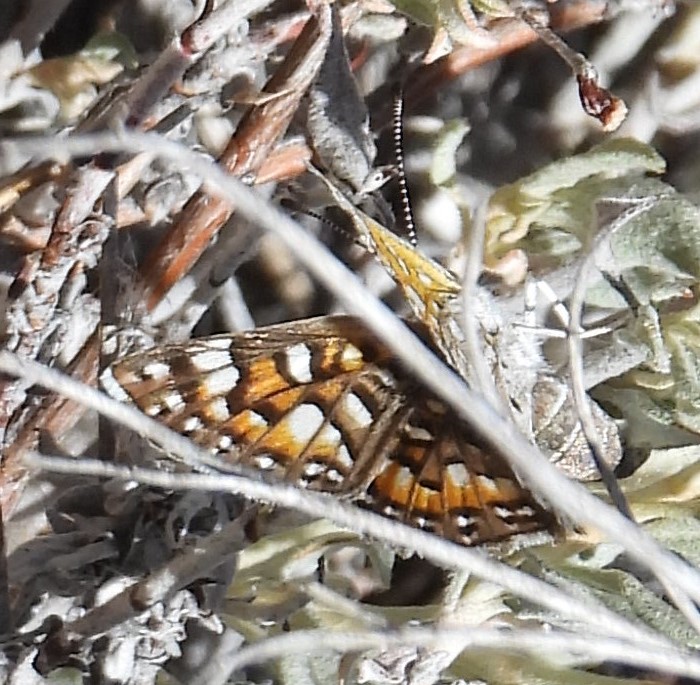
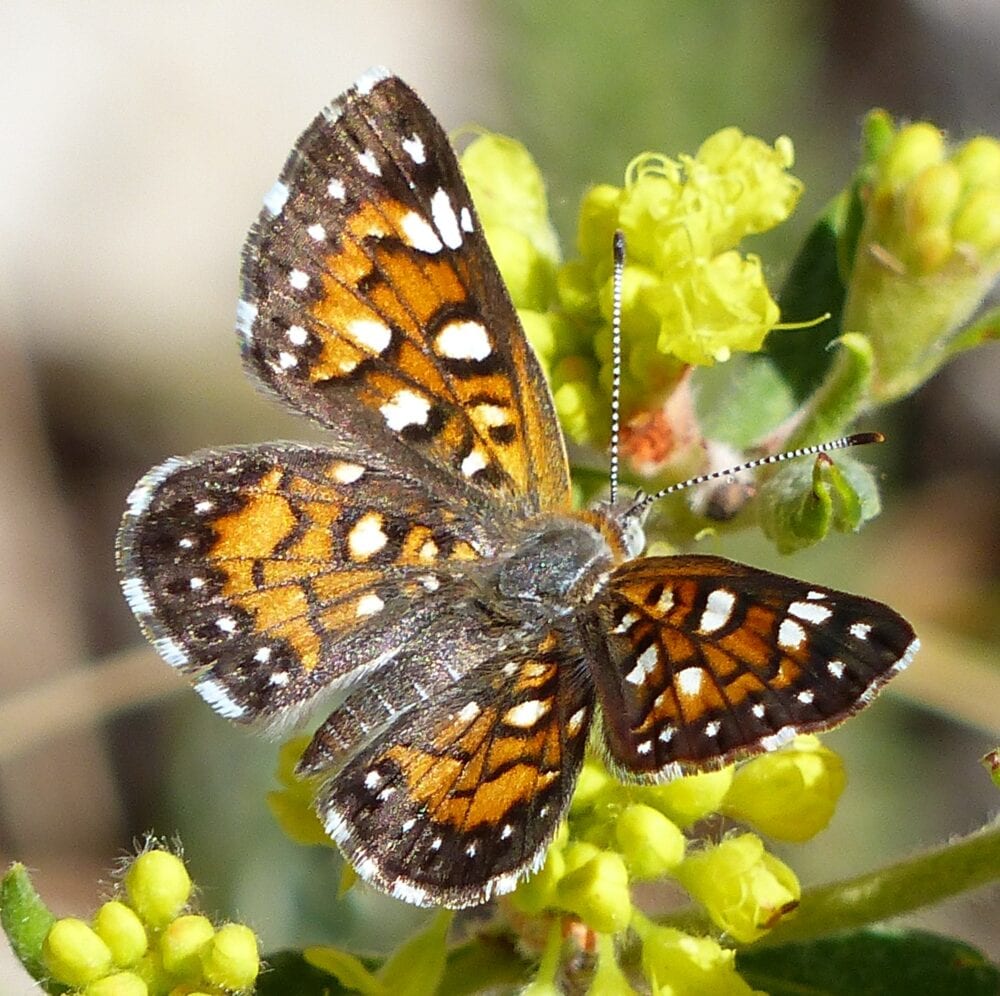
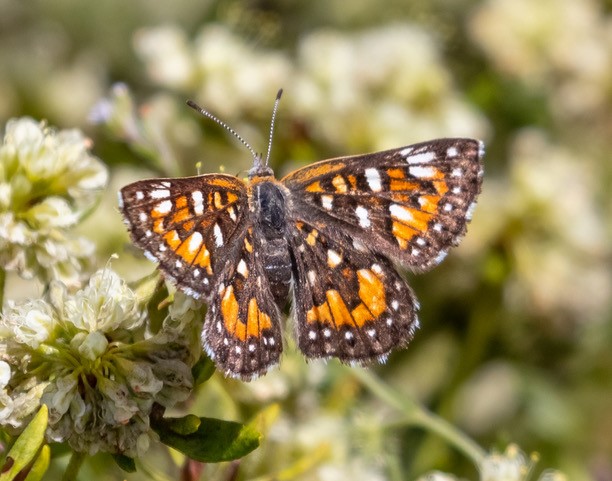

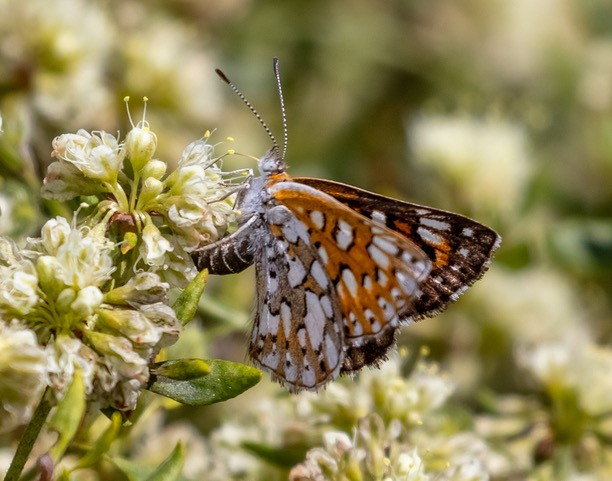
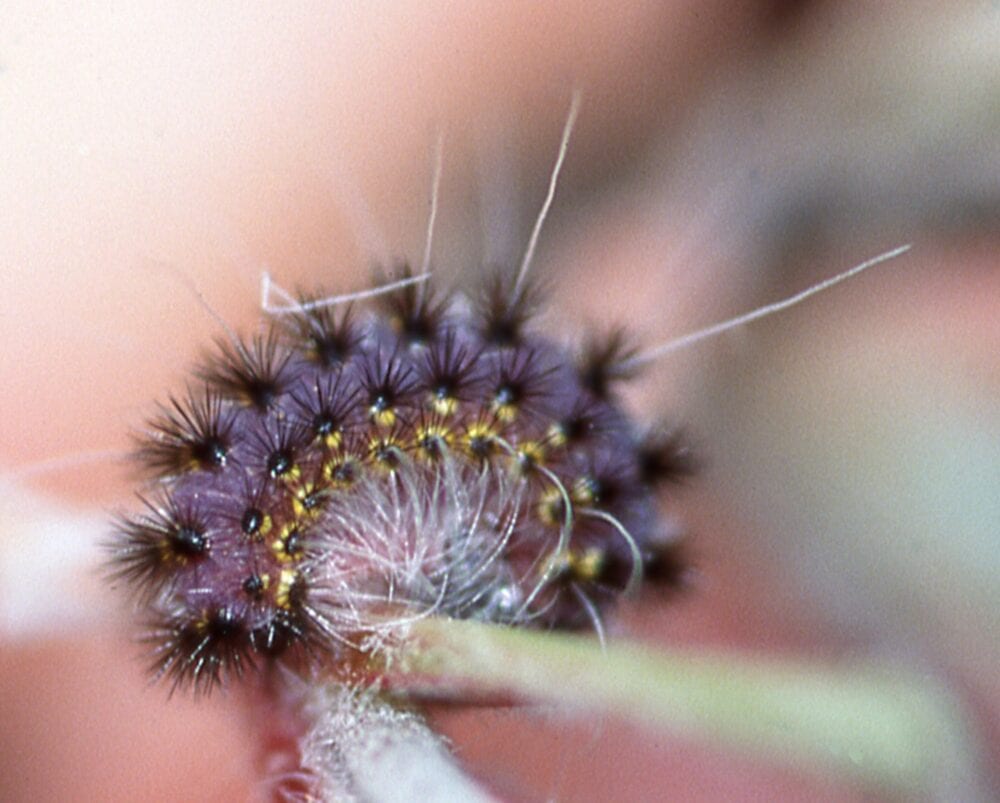
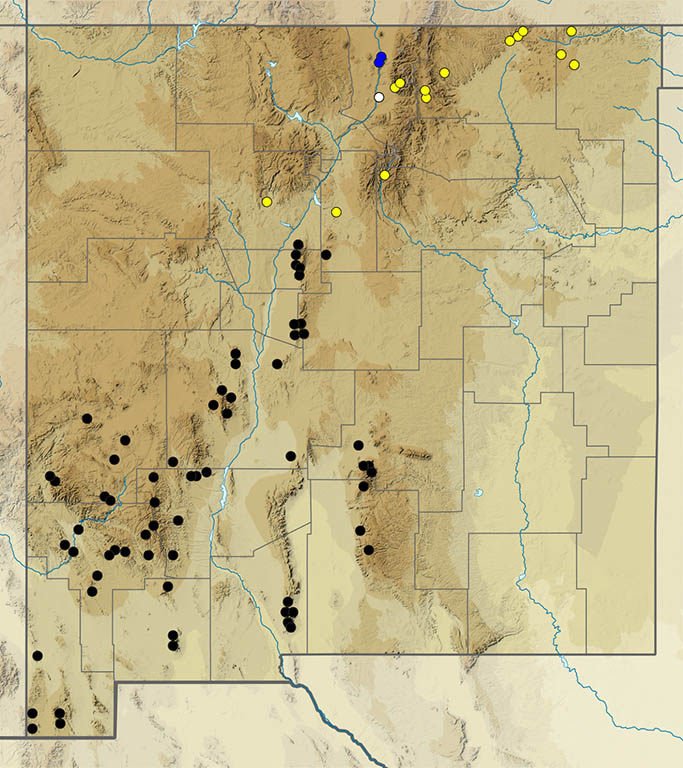
Apodemia duryi (W. H. Edwards 1882) Dury’s Metalmark (updated August 27, 2025)
Description. Dury’s Metalmark has chartreuse eyes and its bright yellow-orange dorsal ground color make it the flashiest member of this complex, at least in New Mexico. The dorsal hindwing median and basal areas are sometimes a shade or two darker. The ventral hindwing is medium gray splattered with white spots of various sizes and a single faint orange streak. Some individuals have a thin coat of orange hairs on the abdomen; their meaning or import remain unknown. Range and Habitat. This butterfly inhabits low elevation flats and rocky terrain of the Trans-Pecos region from Big Bend National Park (TX) west to Hidalgo (MX) and north along the Rio Grande and Pecos River valleys into extreme southern New Mexico (counties: DA,Ed,Ot), always below 5000′. Dury’s Metalmark lives in Chihuahuan Desert scrublands that ring the Organ Mountains. It does not live about 5000′ elevation in the Organ Mountains or in the San Andres Mountains to the north, where Mexican Metalmark prevails. Life History. Larvae eat a spiny Chihuahuan Desert shrub, Littleleaf Ratany (Krameria erecta = glandulosa = parvifolia; Krameriaceae), instead of the various Eriogonum species used by all of Dury’s close relatives. Flight. Three annual broods produce peak numbers of Dury’s Metalmarks in March to April, June, and September. Extreme flight dates in New Mexico extend from February 17 to September 26. Adults fly about the hosts and occasionally seek nectar nearby, visiting Rhus spp. in spring and various yellow composites as they bloom. Males perch and display atop Krameria plants. Comments. (1) This metalmark was discovered 5 miles east of Mesilla (DA) on 20 April 1881 by Ohio naturalist Charles Dury. Tortugas Mountain (= “A” Mountain) is the presumed type locality because it is a prominent landmark located about 5 miles east-northeast of Mesilla and its slopes support Apodemia duryi and its host Krameria erecta in good numbers. (2) Occasional individuals displaying mild DHW smudging have been misconstrued as either Mexican Metalmark or as evidence of interbreeding with Mexican Metalmark. In our opinion, the two species do not encounter each other in a meaningful way. Each stays by its host and the respective hosts generally live on opposites sides of the 5000’ elevation contour. Dury’s Metalmark is a Chihuahuan Desert scrubland species while Mexican Metalmark is its upland (Organ Mountains, San Andres Mountains, Franklin Mountains) Chihuahuan grassland cousin. Their green eyes confirm that Apodemia duryi individuals with a semi-smudged DHW basal area simply represent the dark end of the brightness spectrum for that species.
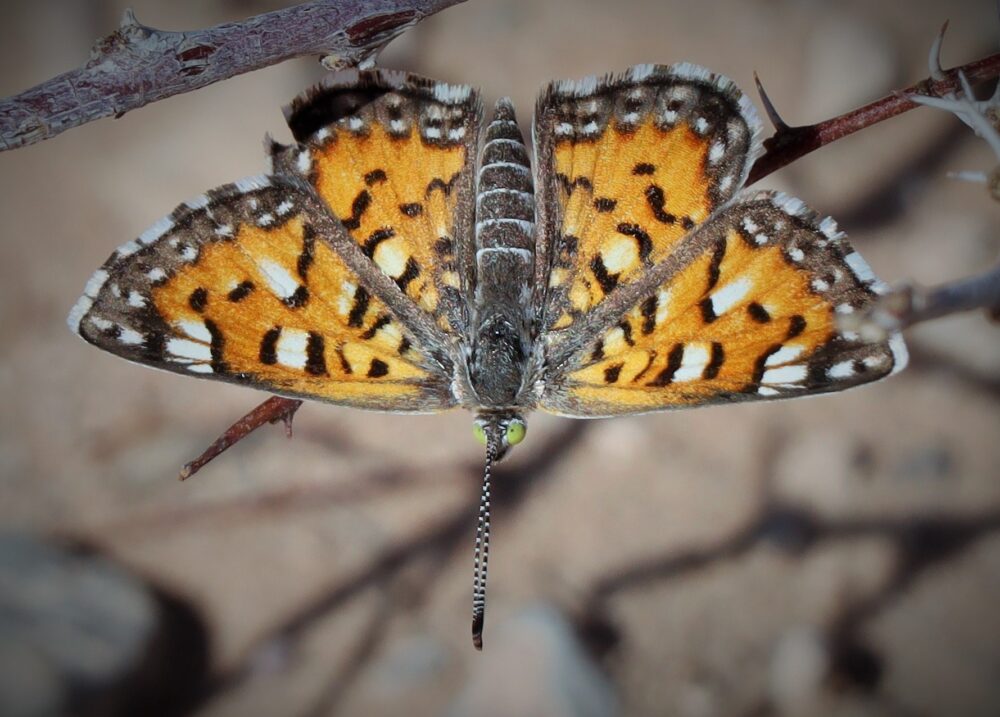

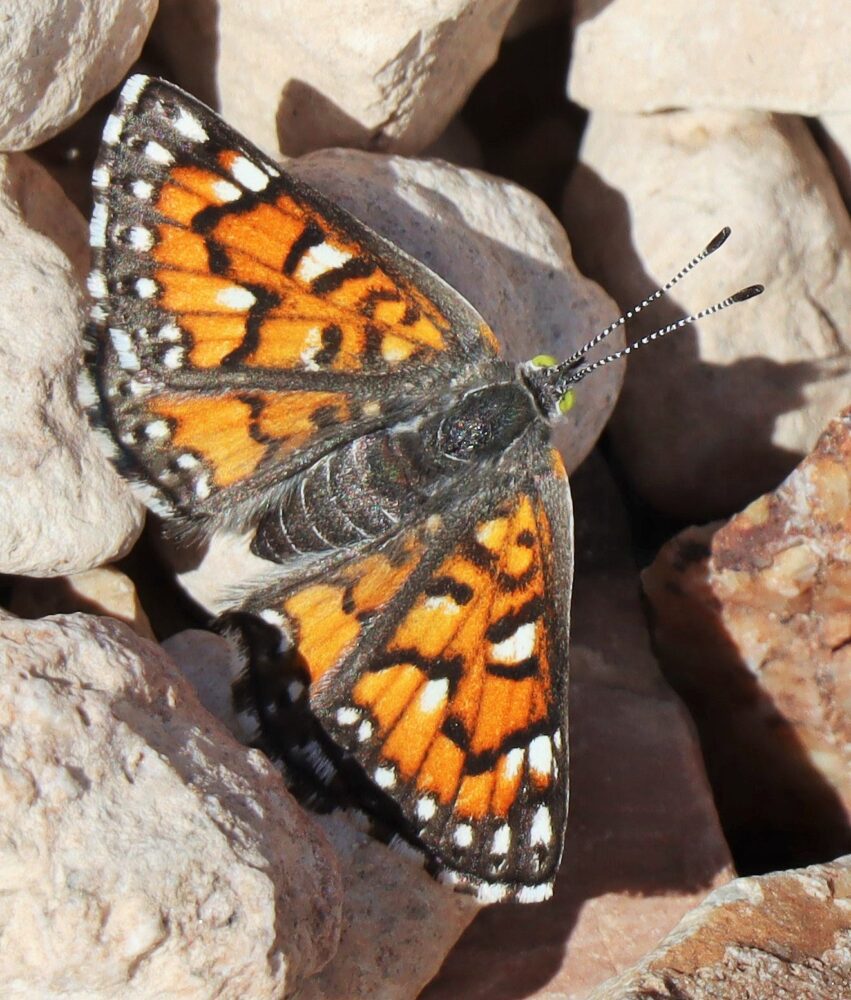
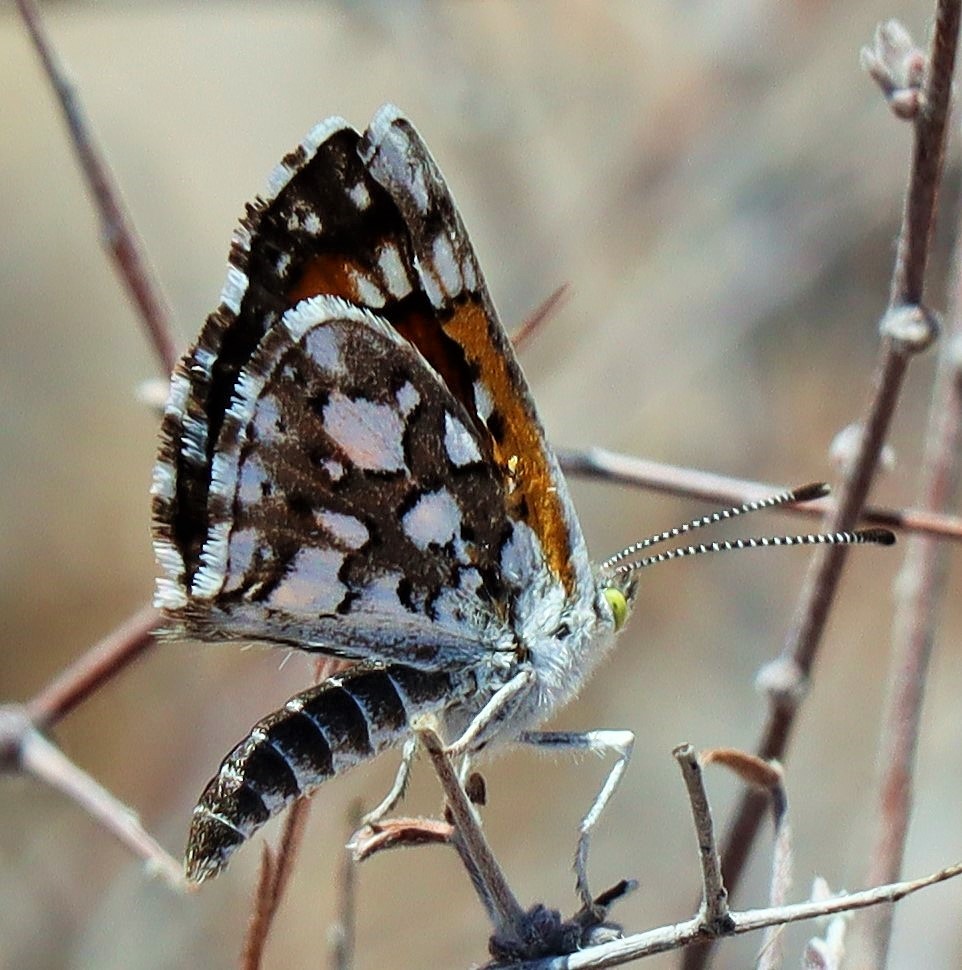
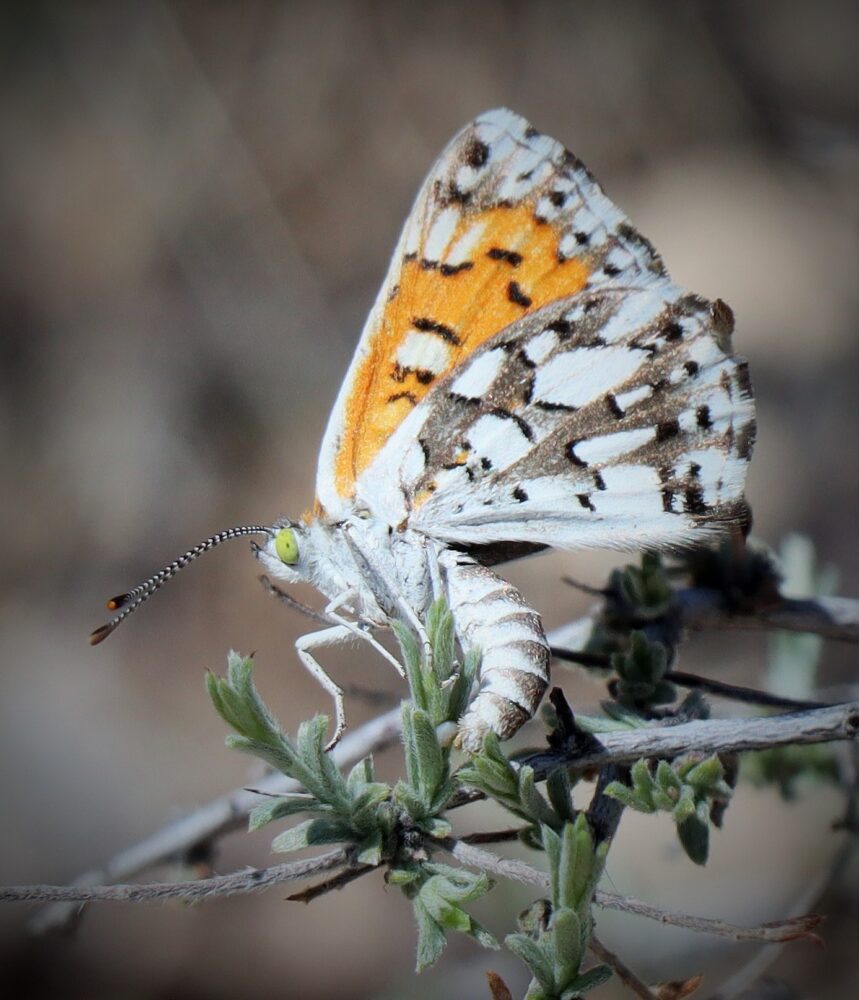
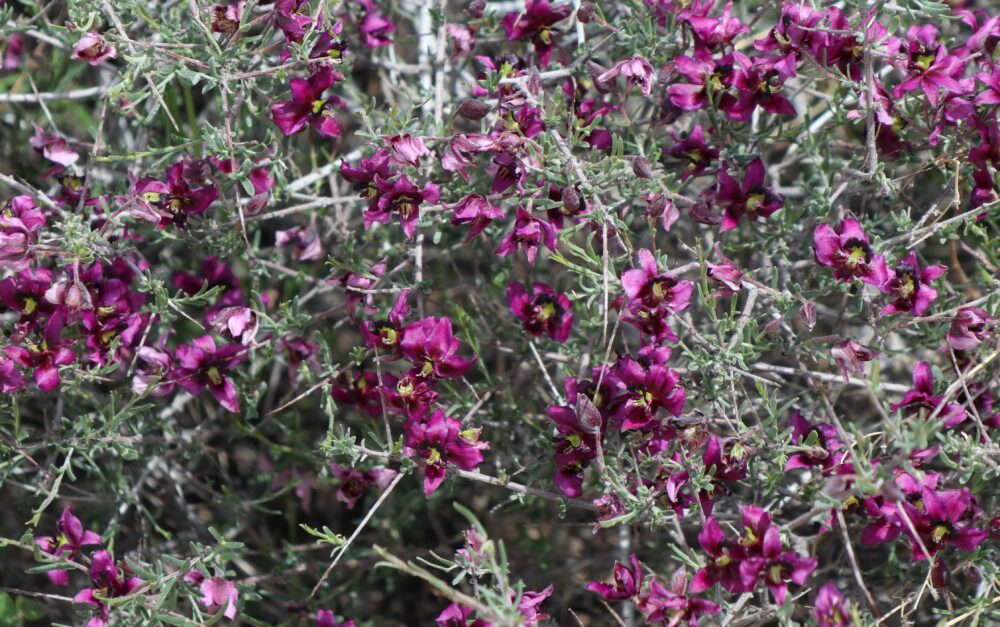
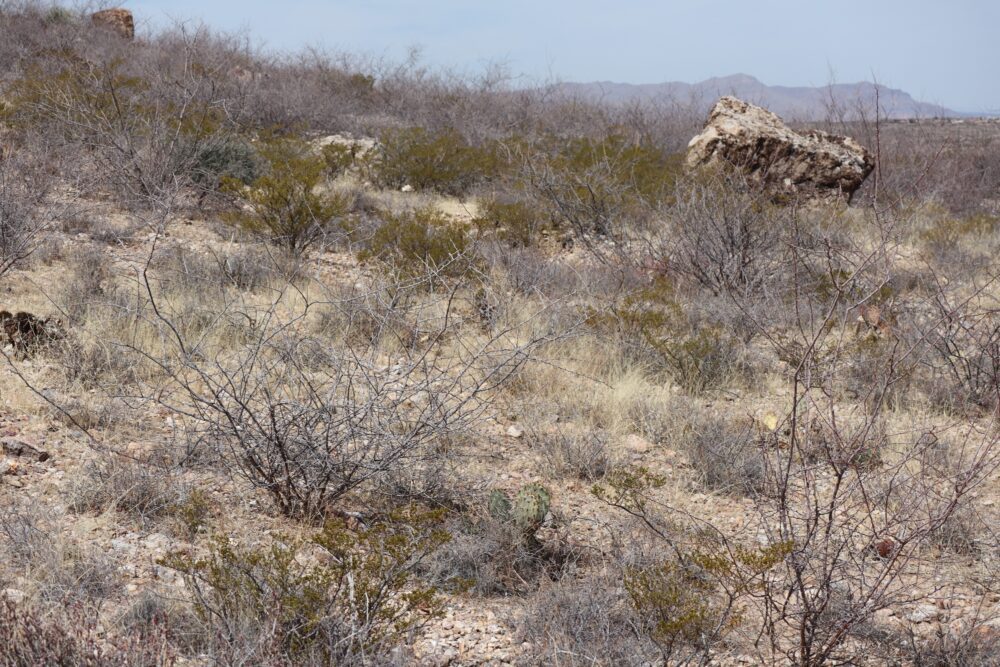
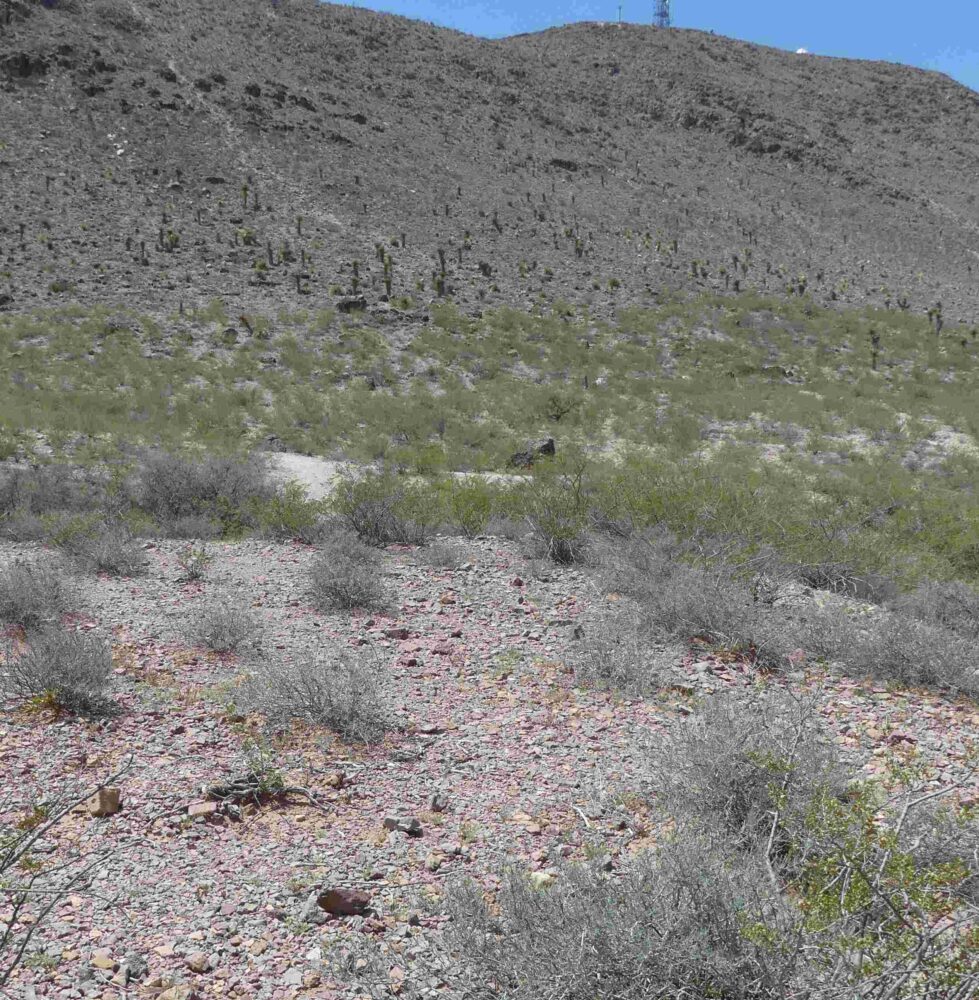
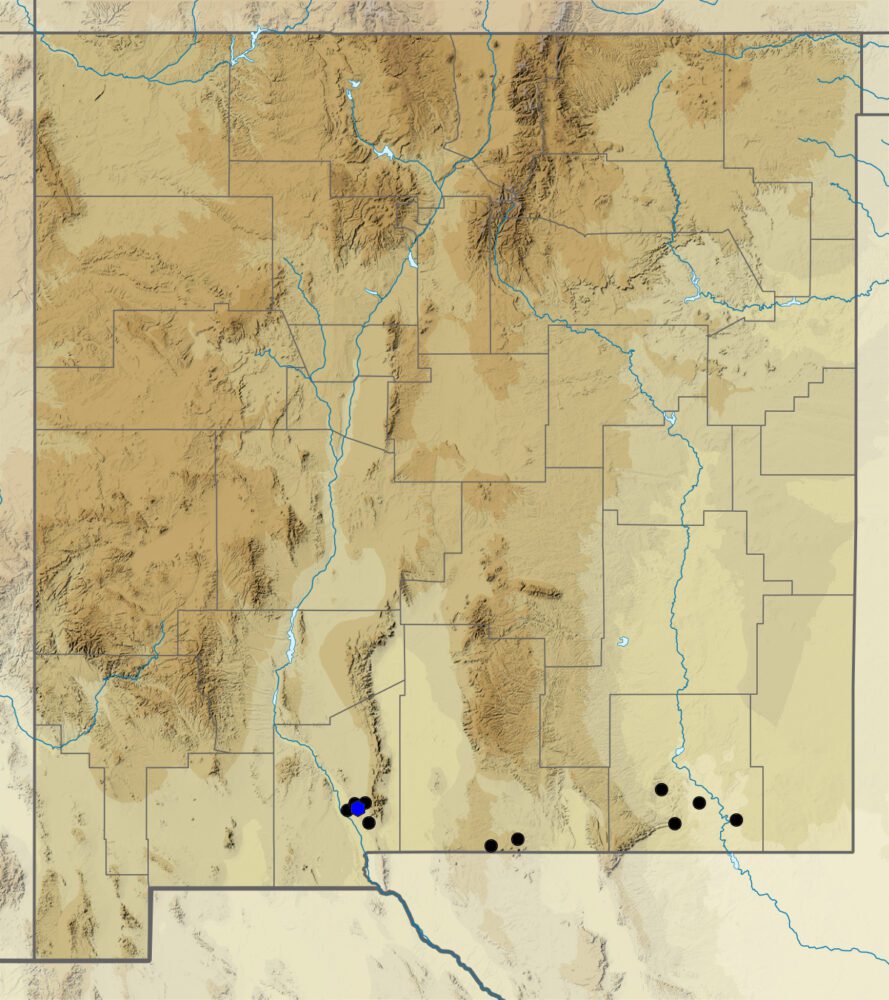
Apodemia nais (W. H. Edwards 1877) Nais Metalmark (updated March 26, 2022)
Description. Nais Metalmark resembles a copper in terms of wing characters and it was originally described as one! It is bright orange above, sprinkled with black and with a white patch near the forewing costa. It is silver-white and orange beneath. Range and Habitat. Nais has a limited range in the mountains of CO, AZ, NM and the Sierra Madre. It prefers shrubby savannas with the host. In NM it occupies major northern and western mountains (counties: Be,Ca,Ci,Co,Gr,LA,MK,RA,Sv,SM,SF,Ta,To), 6700 to 9200′ elevation. Life History. Fendler’s Buckbrush (Ceanothus fendleri; Rhamnaceae) is the only known larval host in NM and CO. Partially grown larvae diapause through winter. Flight. Adults are in flight during one annual generation between June 12 and August 29, with peak numbers in July. They like to fly and perch near the host and nectar at its flowers, often alongside two other Ceanothus feeders: Callophrys affinis and Erynnis pacuvius. Comments. While living in Prescott, AZ, Winslow J. Howard, a frontier jeweler and naturalist, collected the type specimen for W. H. Edwards’ description of Apodemia nais in 1877. Four years later, in August 1880, University of Kansas Professor and entomologist Francis H. Snow found Apodemia nais at about 8000’ in the Santa Fe River Canyon (SF), for our first NM record of this species. It’s interesting that no A. nais have turned up in the Sacramento or Guadalupe mountains. A closely related species occurs in Big Bend National Park, TX, so any Apodemia “nais” that may turn up in SE NM mountains should be closely examined.
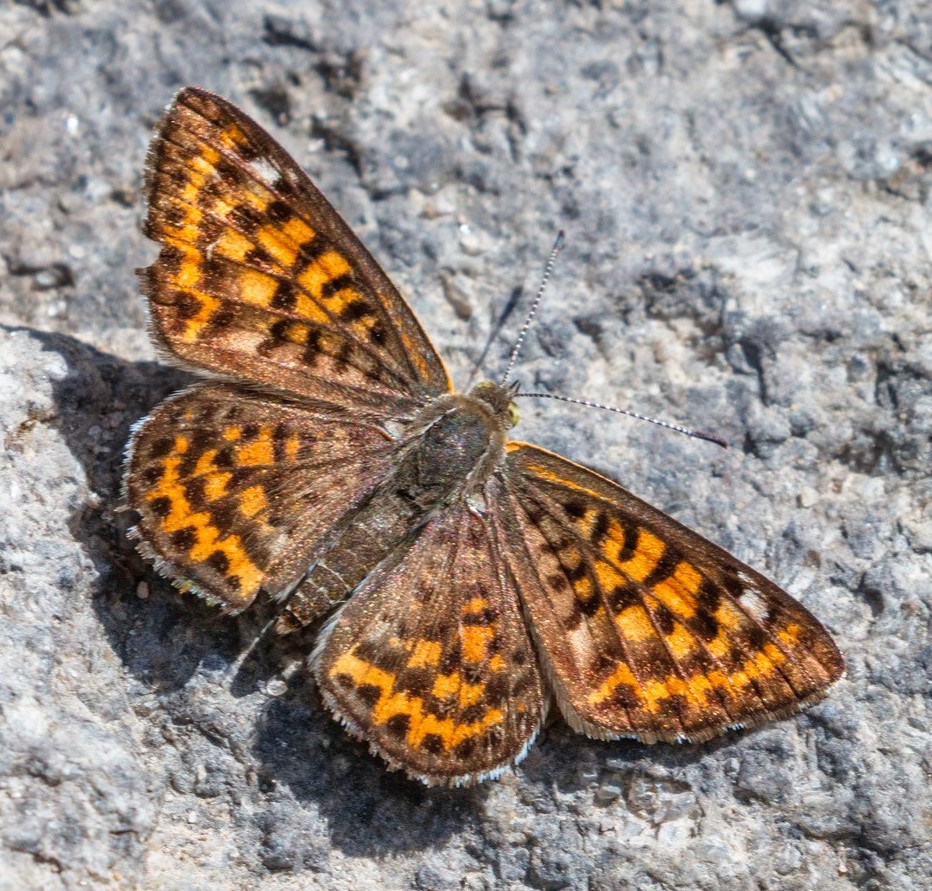
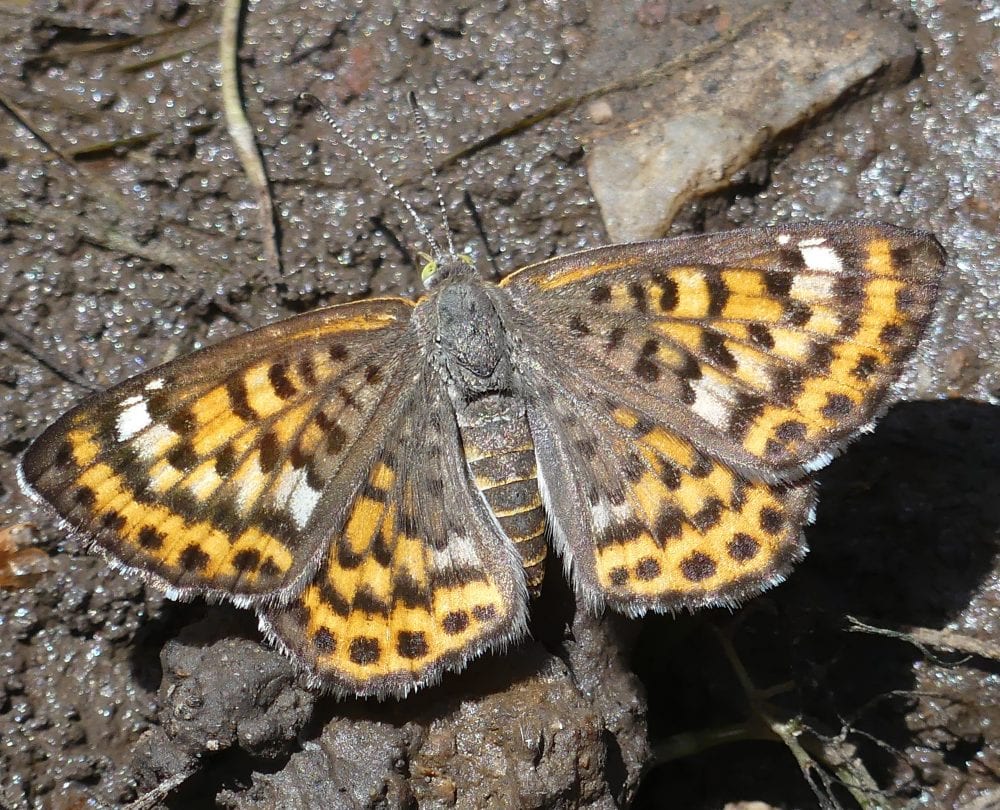
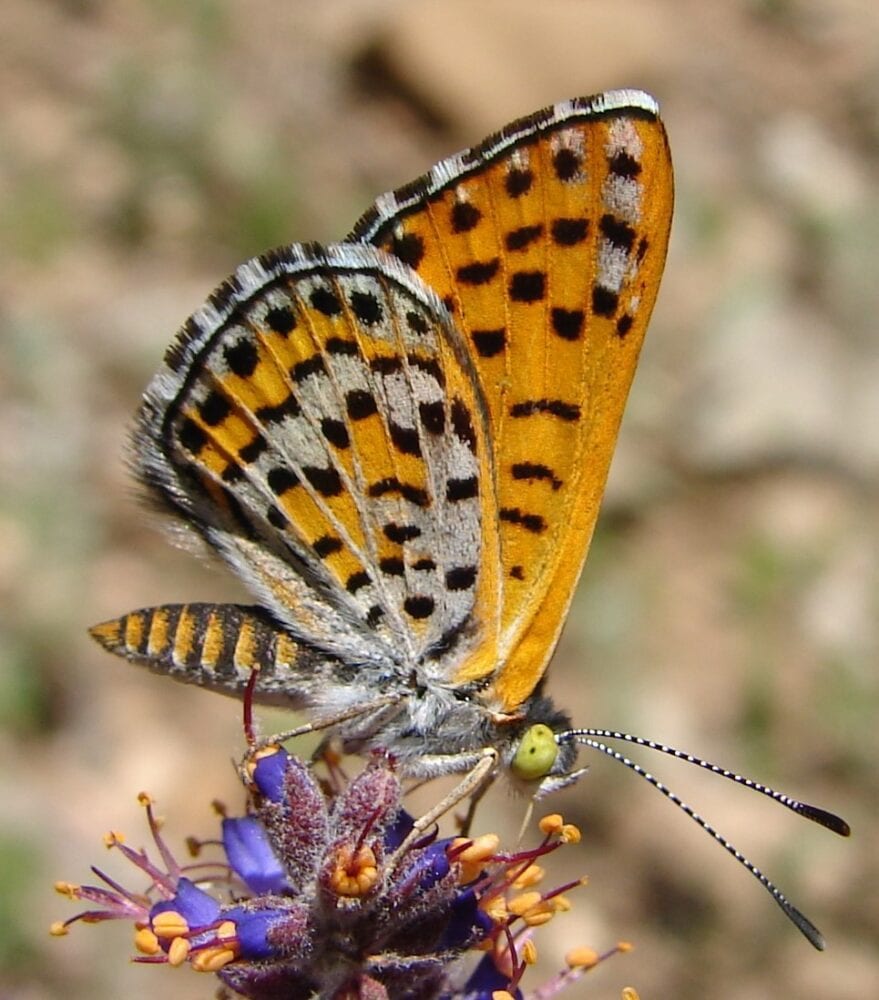
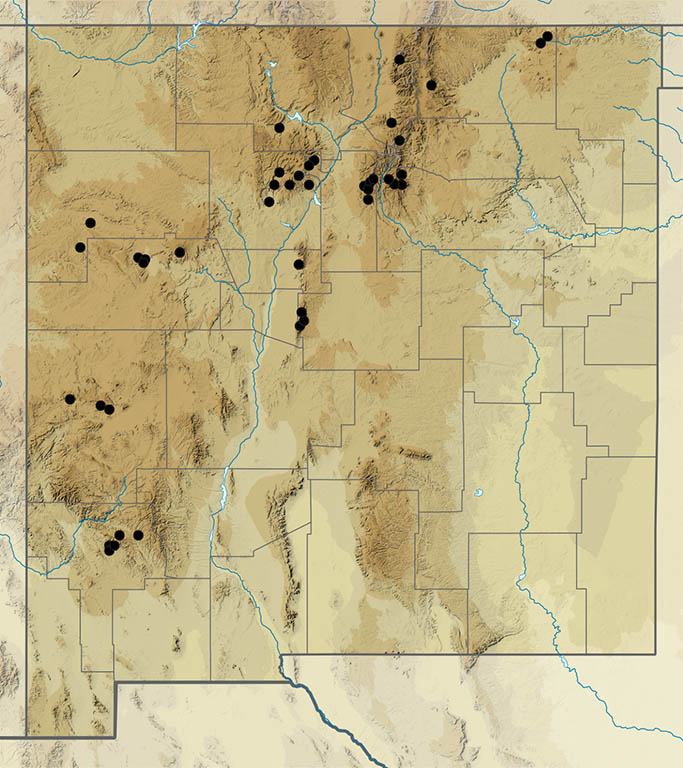
Apodemia ares (W. H. Edwards 1882) Ares Emesis (updated March 27, 2022)
Description. This and the next species are the same size and can be difficult to separate. Formerly called Ares Metalmark, Ares Emesis is distinguished by a DFW cell lacking dark gray patches and a forewing apex that is not hooked. The DHW is gray on the posterior half and orange toward the costa. Ares markings appear precise, while Cleis Emesis (formerly Zela Metalmark) markings seem a bit blurred. Range and Habitat. Ares has a limited distribution in the northern Sierra Madre of Mexico, southeast AZ and southwest NM. It has been found in Upper Sonoran Zone savannas in the Peloncillo and Animas Mountains (Hi), between 4700 and 6500′ elevation. Life History. Larvae eat Quercus oblongifolia, Q. emoryi and perhaps other oaks. Flight. Unlike Zela, Ares is single-brooded with adults in flight only during the summer monsoon. Records span July 21 to September 24, with peak adult numbers in August. Adults are only too happy to visit canyon flowers. Comments. Occasional summer individuals seem to be intermediate between A. ares and A. cleis, raising some doubt about their status as separate species. Perhaps A. zela is dimorphic in its autumn brood? Research is needed to better understand the relationship between these two insects.
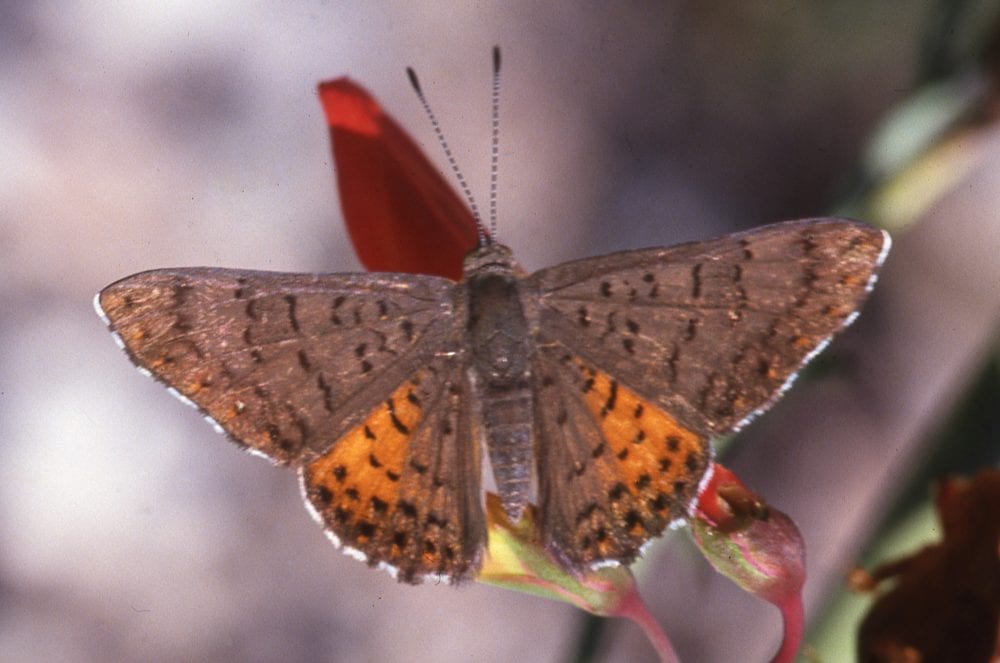
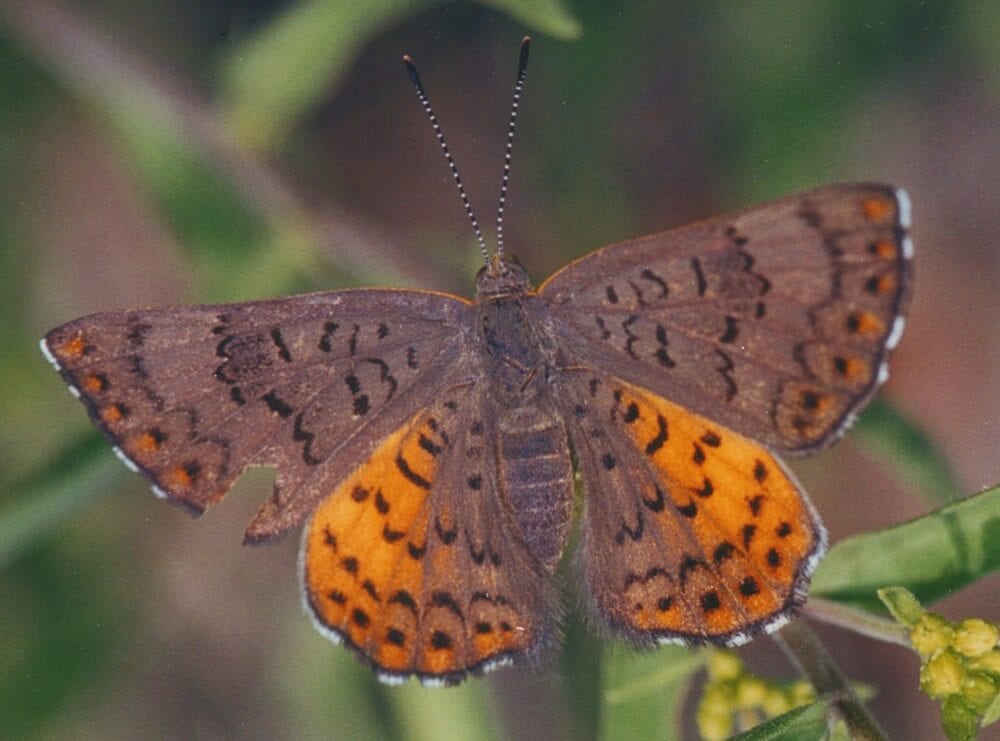
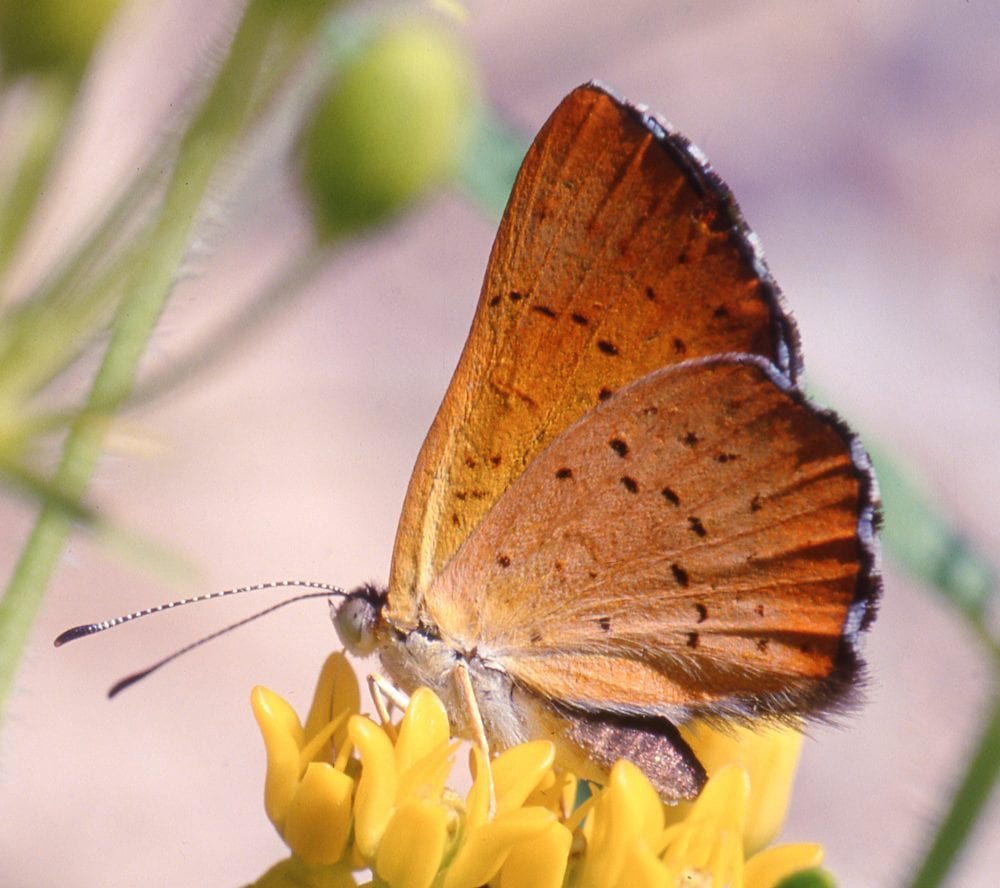


Apodemia cleis (W. H. Edwards 1882) Cleis Emesis (updated August 19, 2024)
Description. With a wingspan exceeding one inch, Cleis Emesis is slightly larger than most other North American Riodinids. Like Ares, it is tangerine-orange below with dark spots in loose rows. The forewing has a subtle apical hook and is gray-brown above with dark patches at basal and distal ends of the forewing cell. The hindwing is gray above, grading into pale orange with rows of small, dark spots. Range and Habitat. Cleis Emesis occurs from the northwestern Mexico northward into the southwestern US along the Sierra Madre. In NM it occupies Upper Sonoran Zone savannas in our SW quadrant (counties: Ca,Gr,Hi,Si), typically 4500 to 7500′ elevation. Life History. Larval hosts remain unconfirmed, but Arizona Sycamore (Platanus wrightii) is strongly suspected in Arizona (Bailowitz and Brock 2022). Flight. Cleis Emesis is bivoltine with adult numbers peaking in April and again in August. All our records fall between March 6 and September 5. Look for adults on flowers in canyon bottoms and in streamside meadows. Comments. US populations were formerly treated as a subspecies of Apodemia zela (Butler 1870), but Zhang et al. (2022) reinstated cleis (W. H. Edwards 1882) as a full species, based on genomic studies, and BOA has adopted that approach. Recent records from Grant and Sierra counties might suggest northward or eastward range expansion (or incomplete prior information). Cleis Emesis, Zela Emesis and Ares Emesis were recently shifted out of the genus Emesis Fabricius and into Apodemia based on genomic studies.
